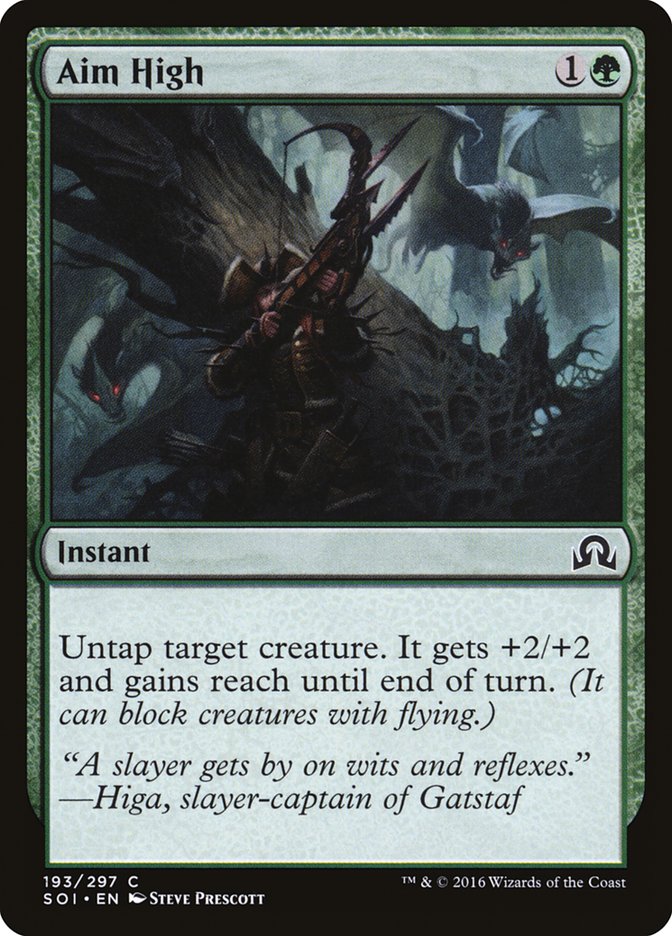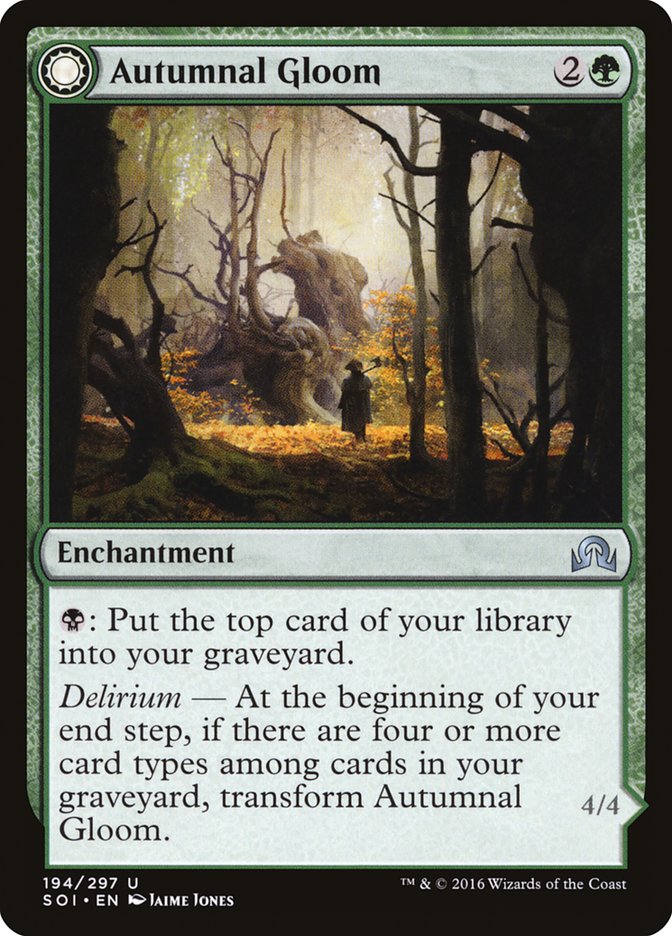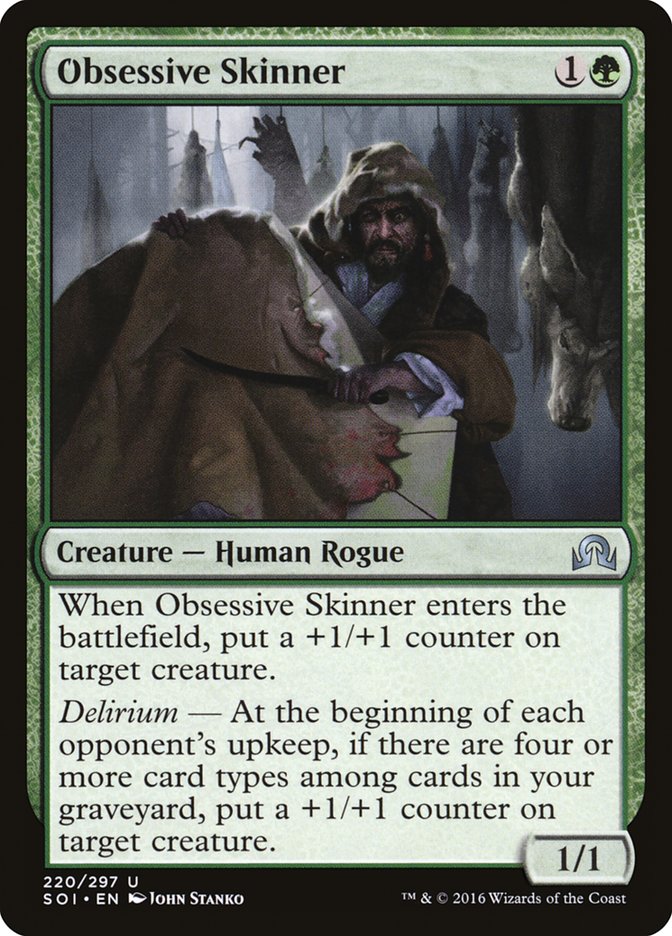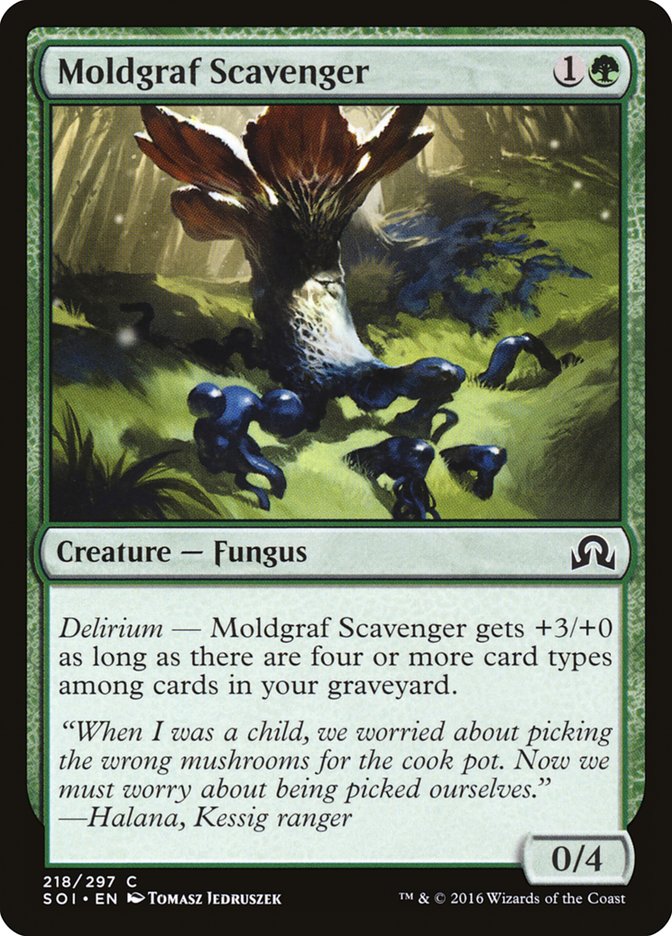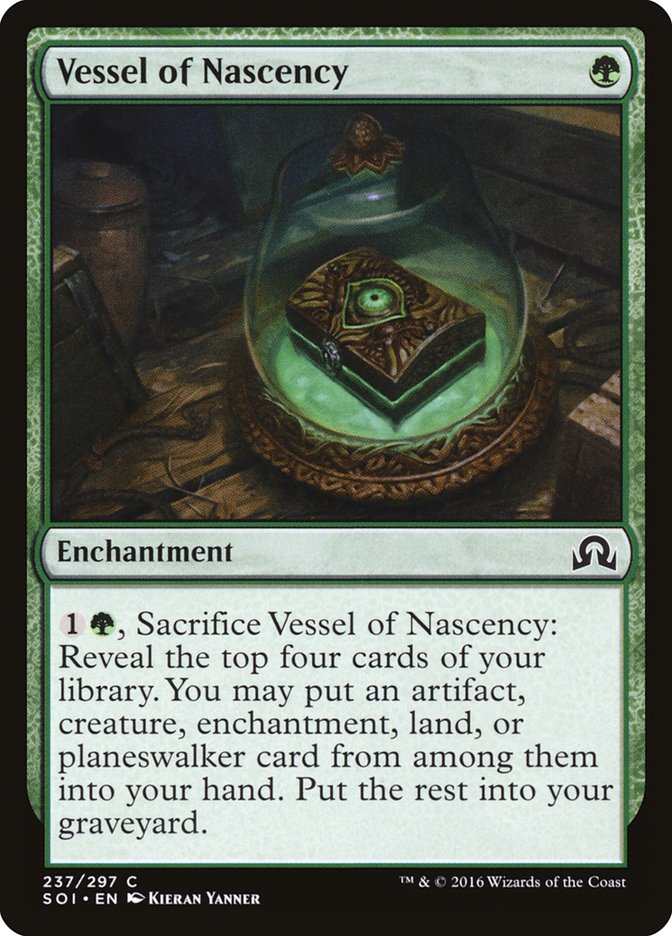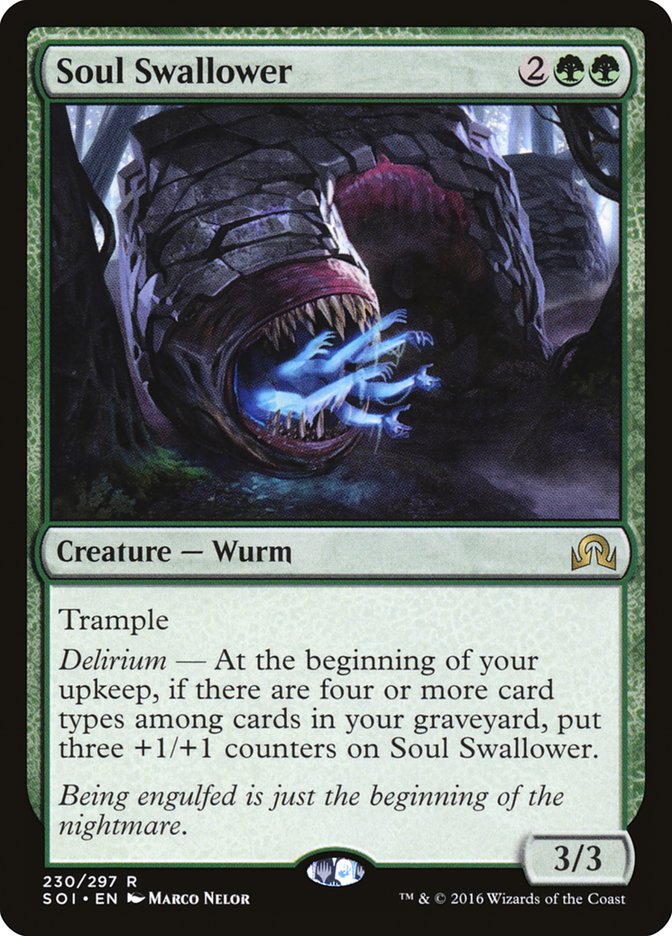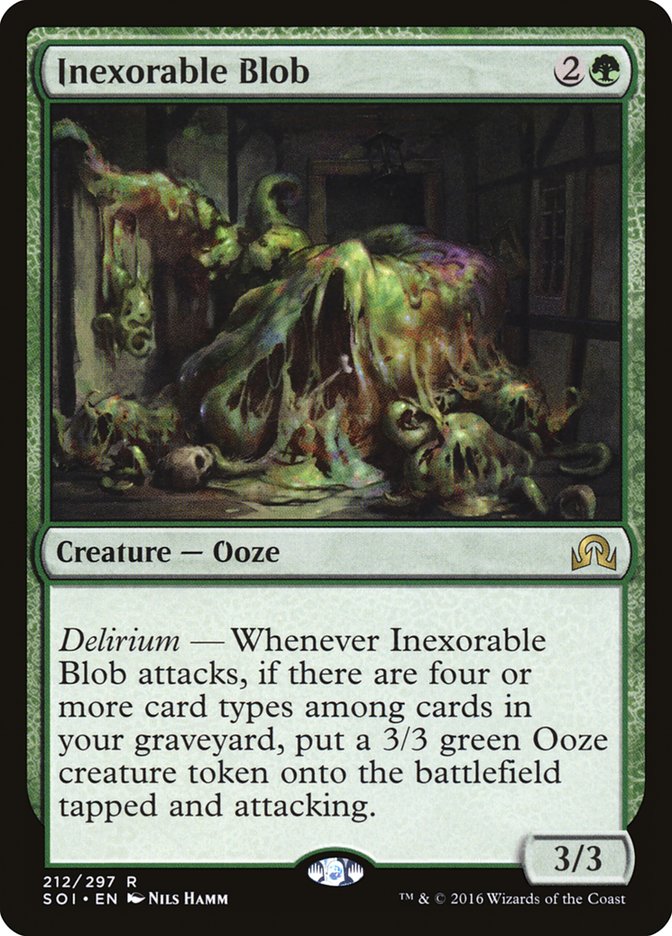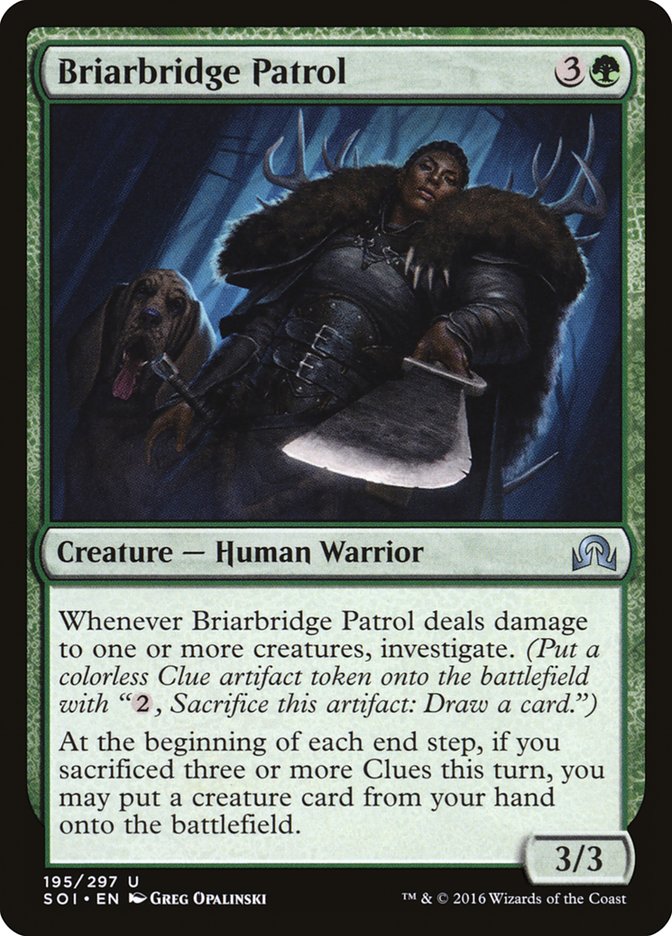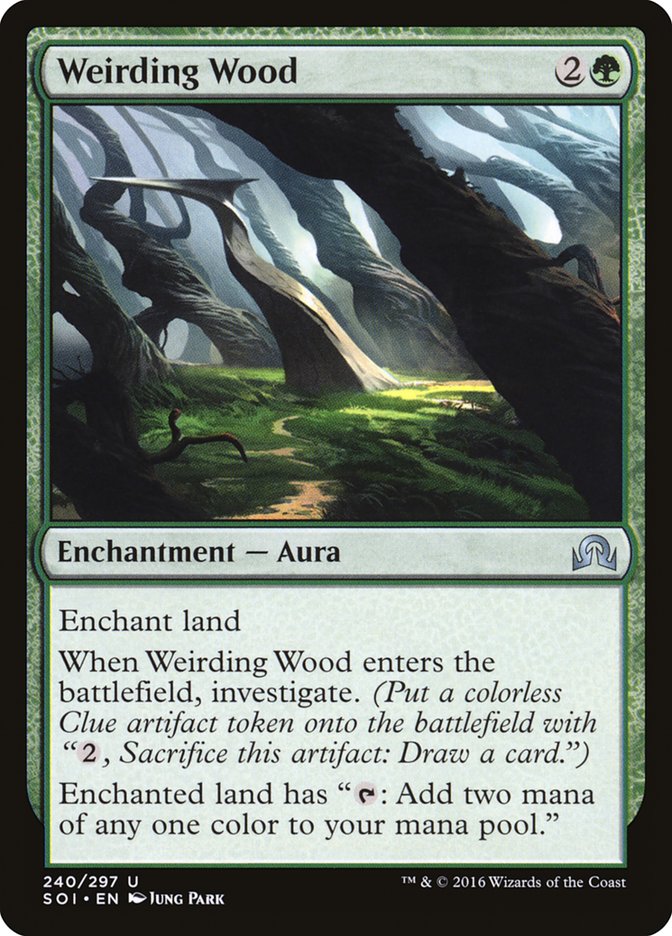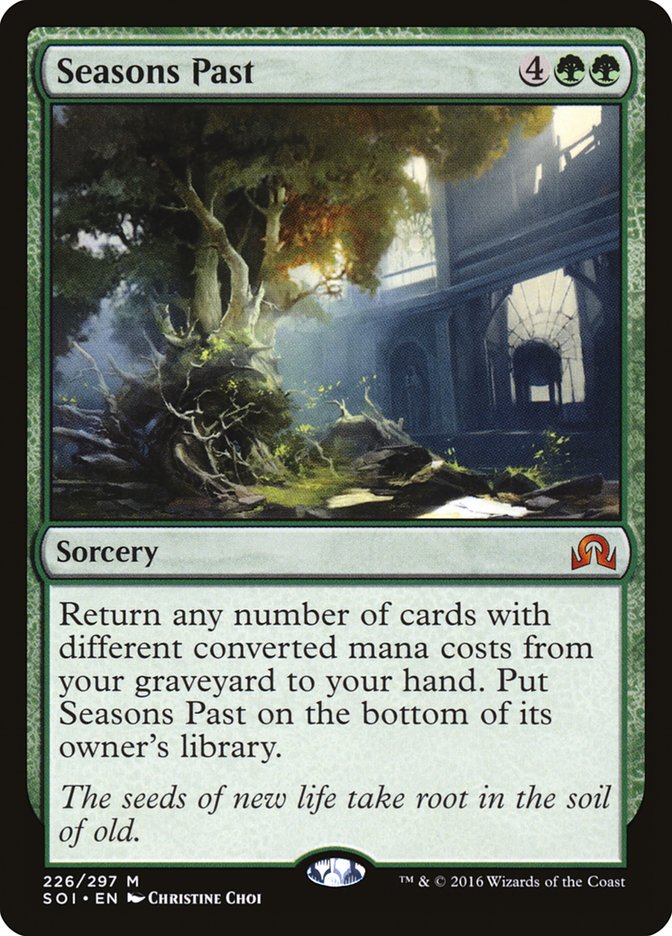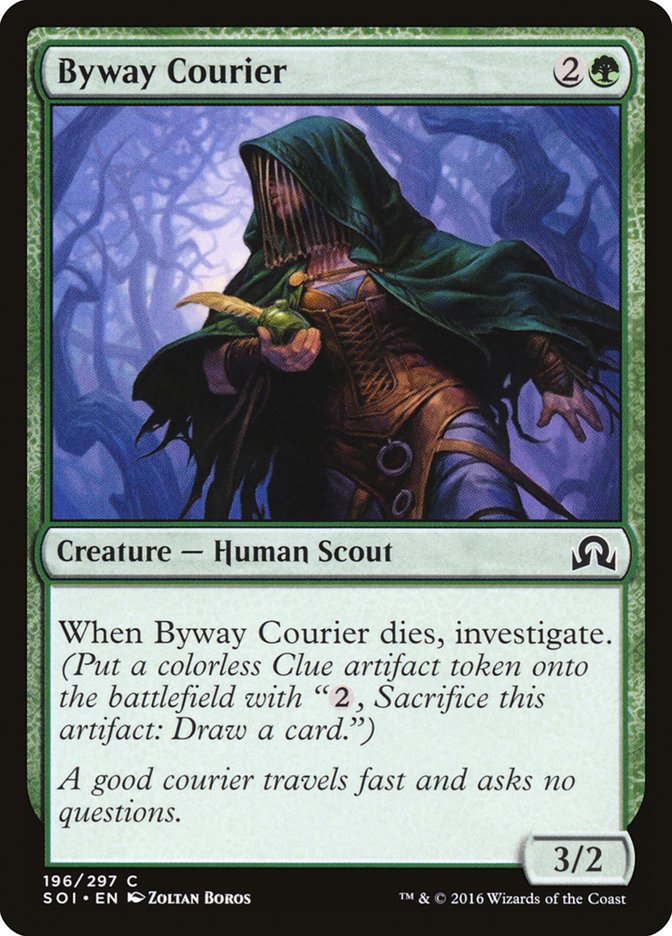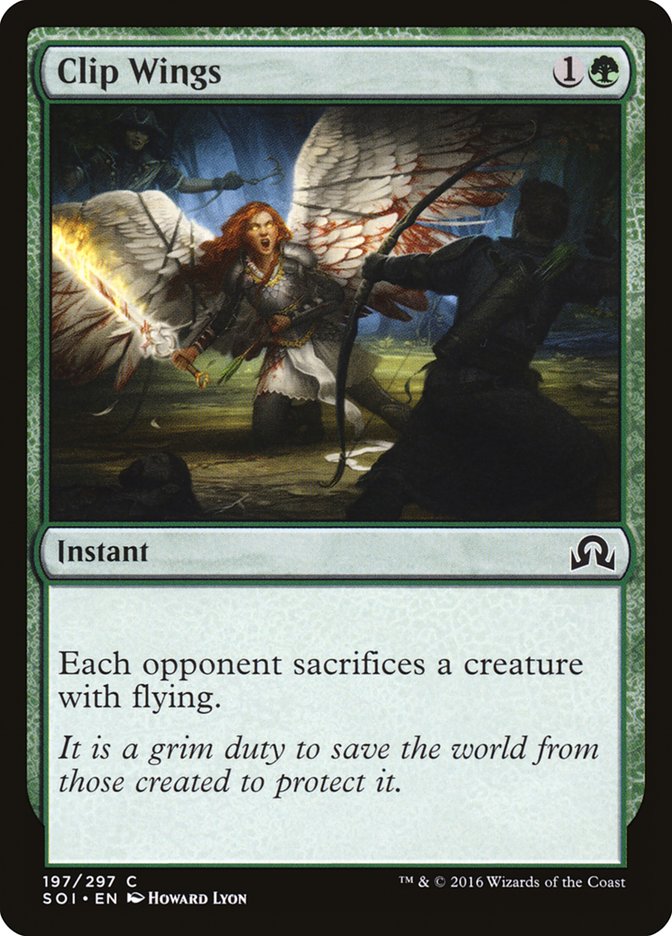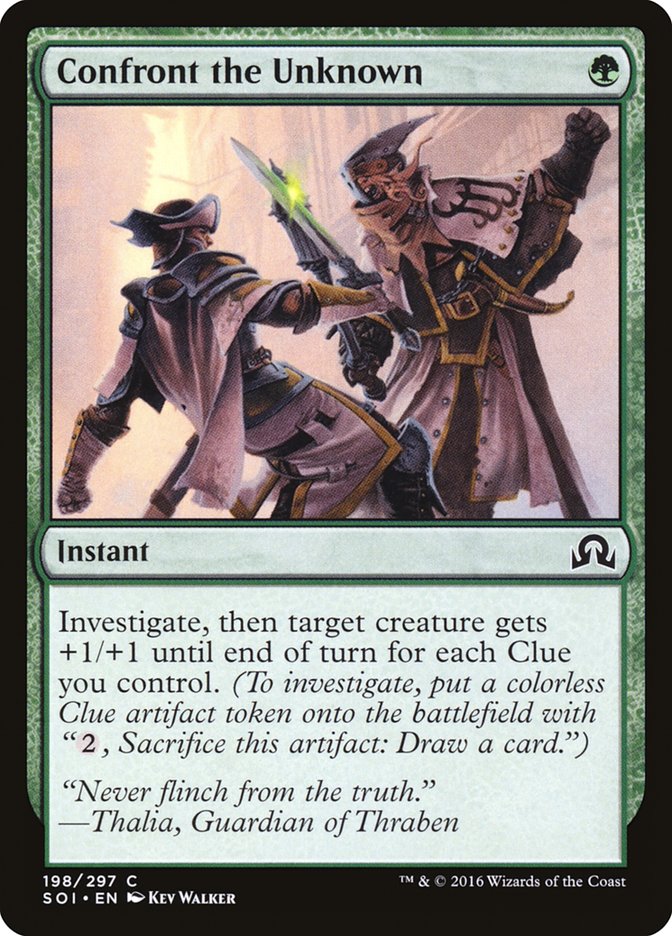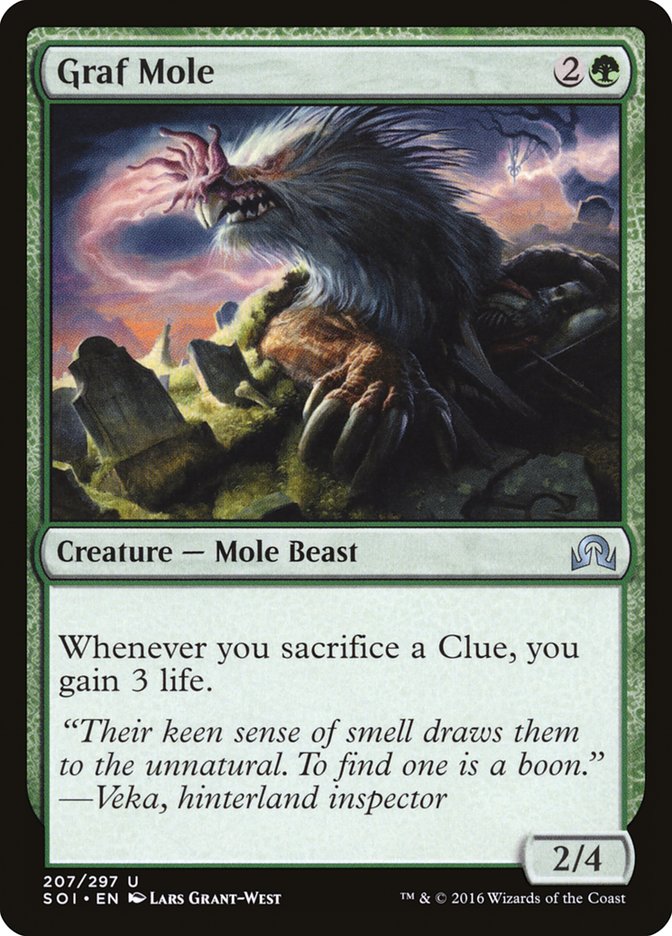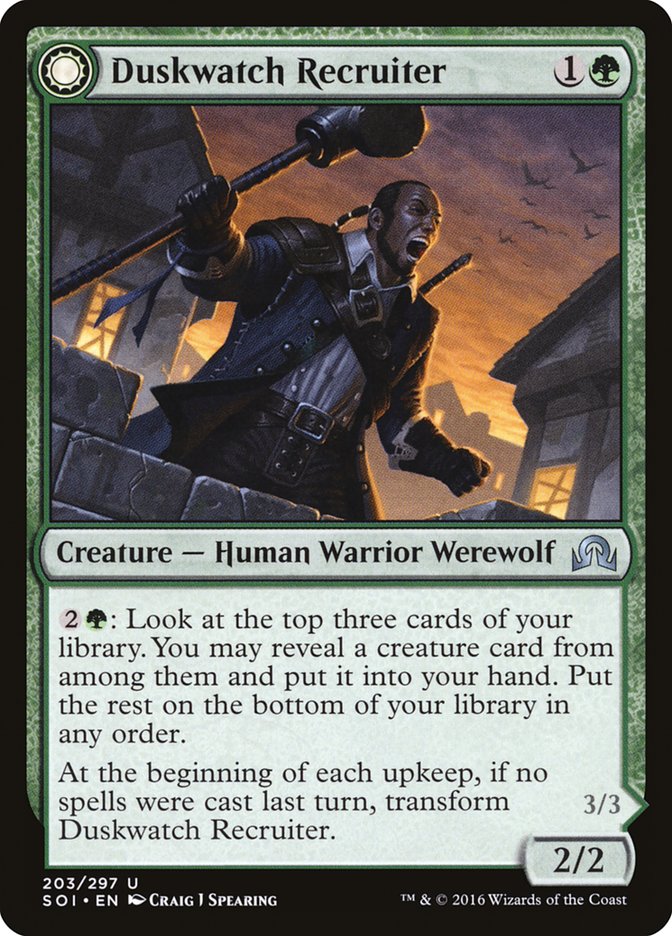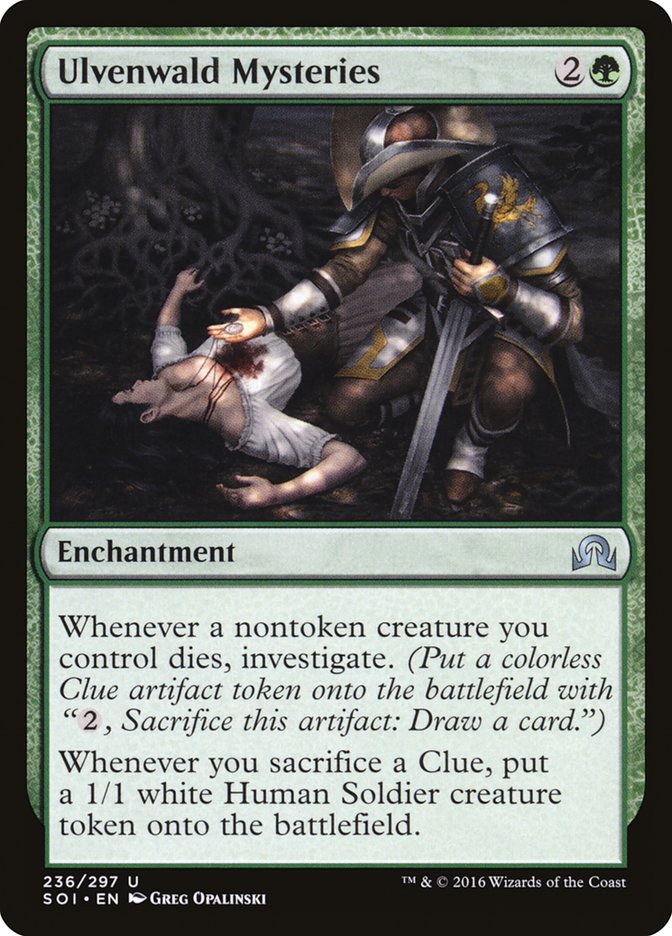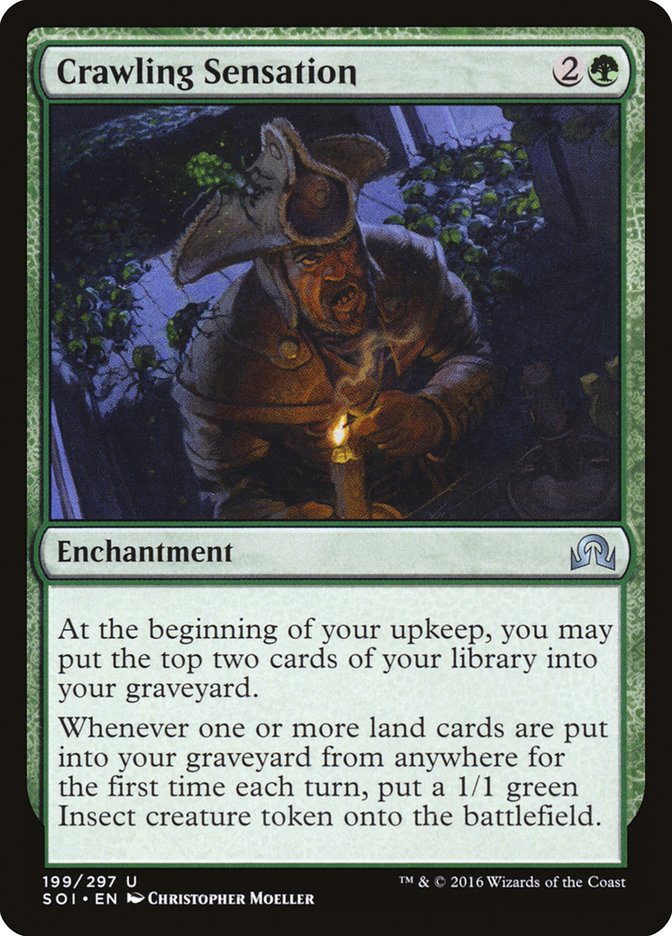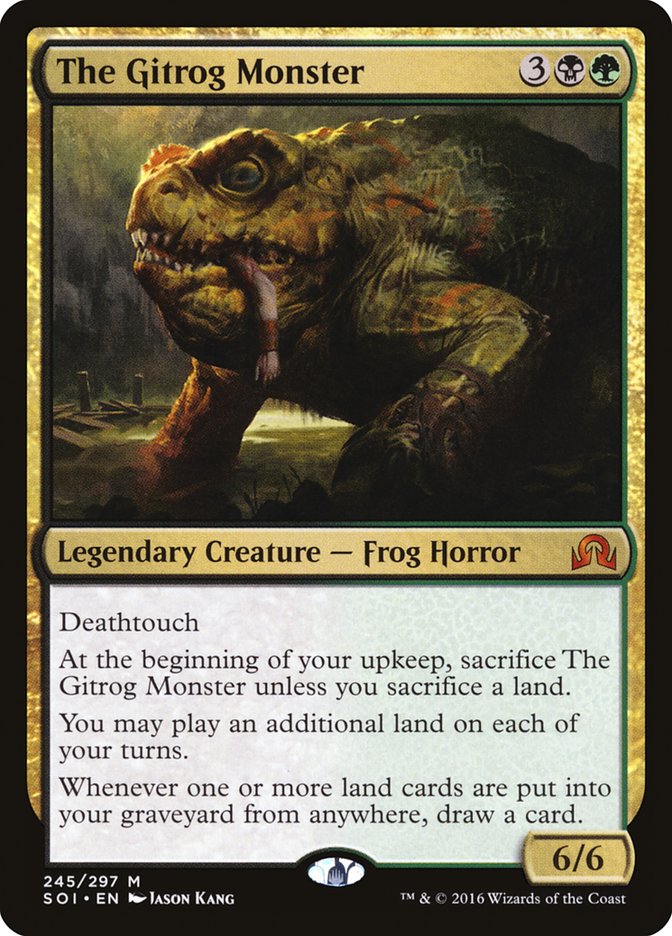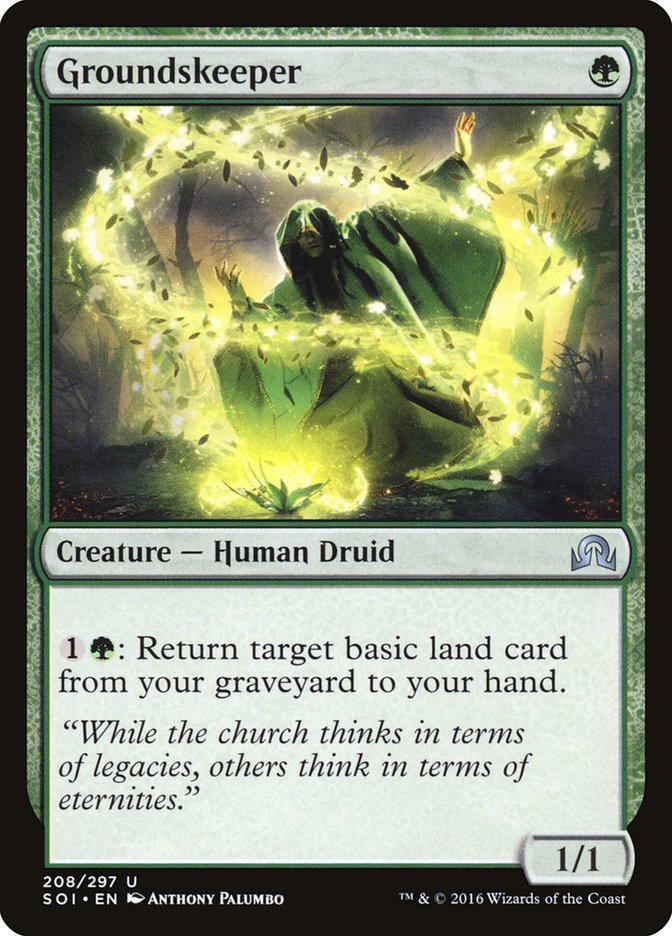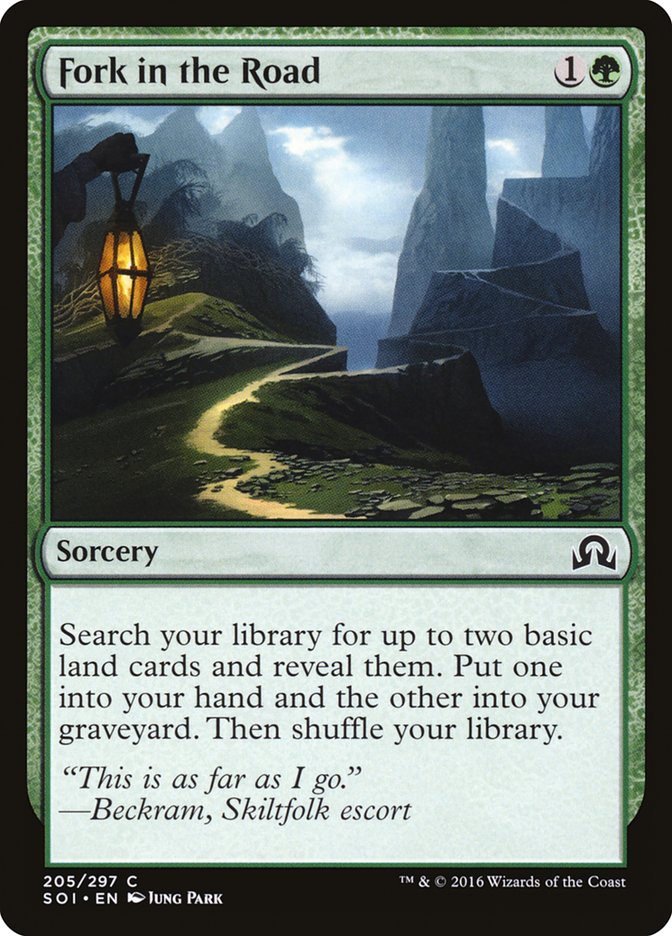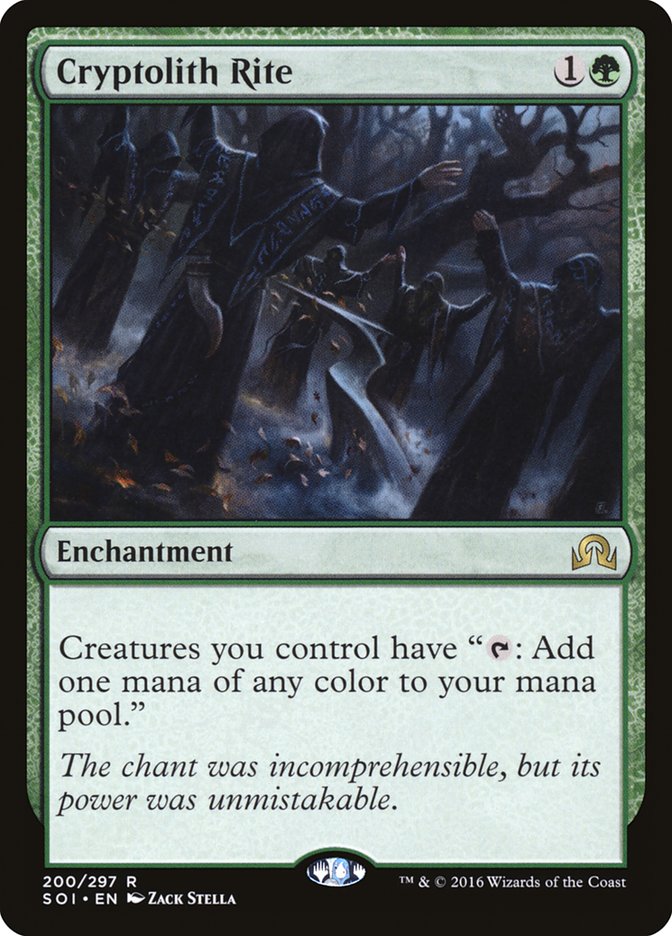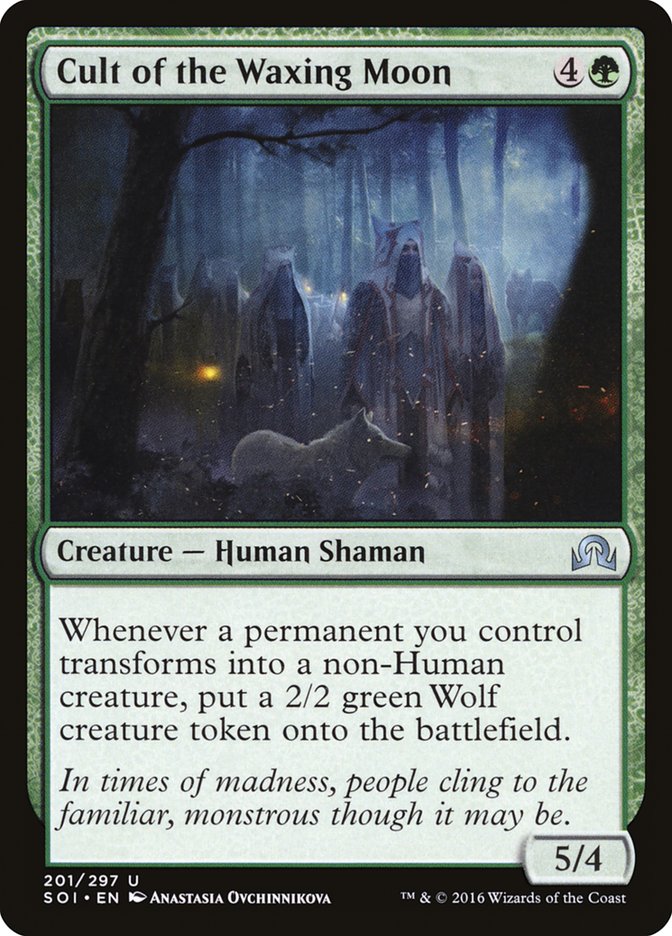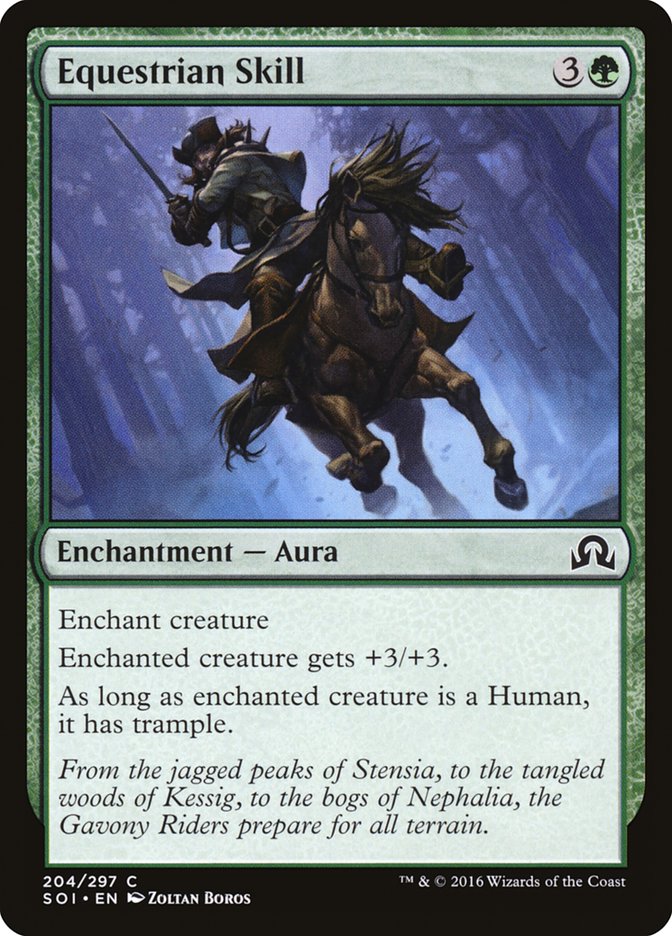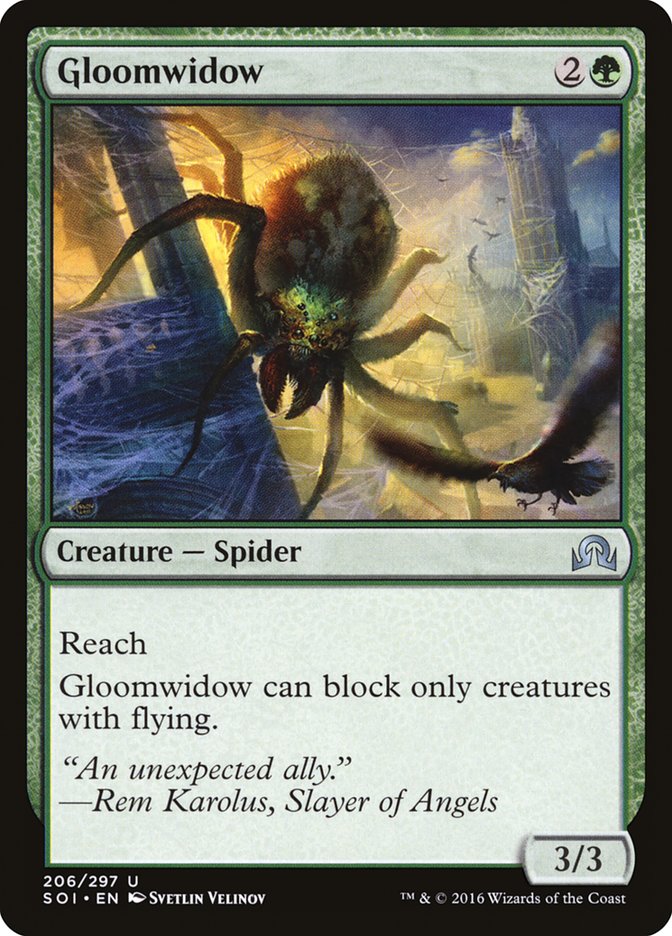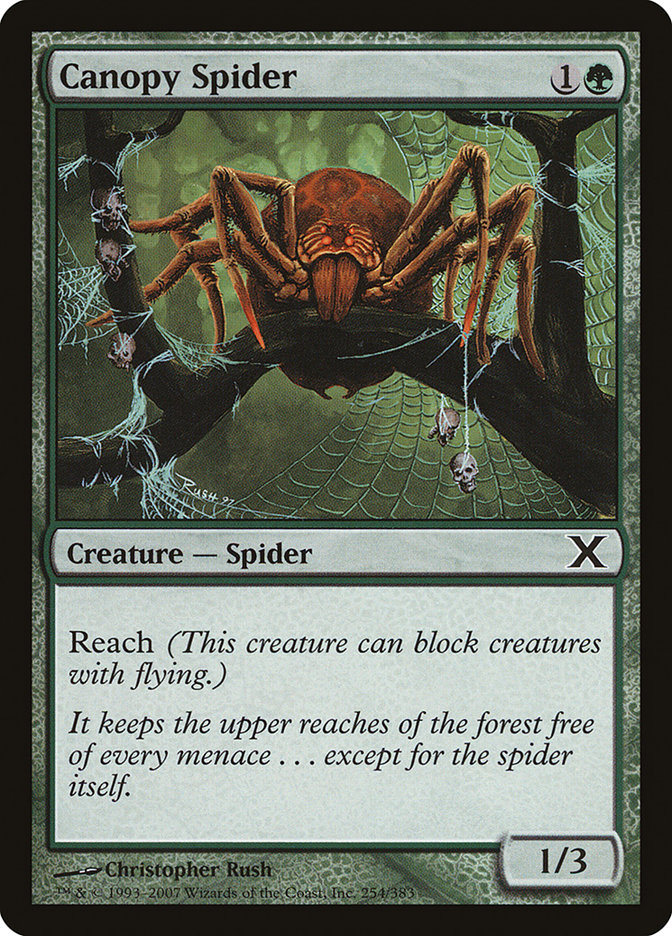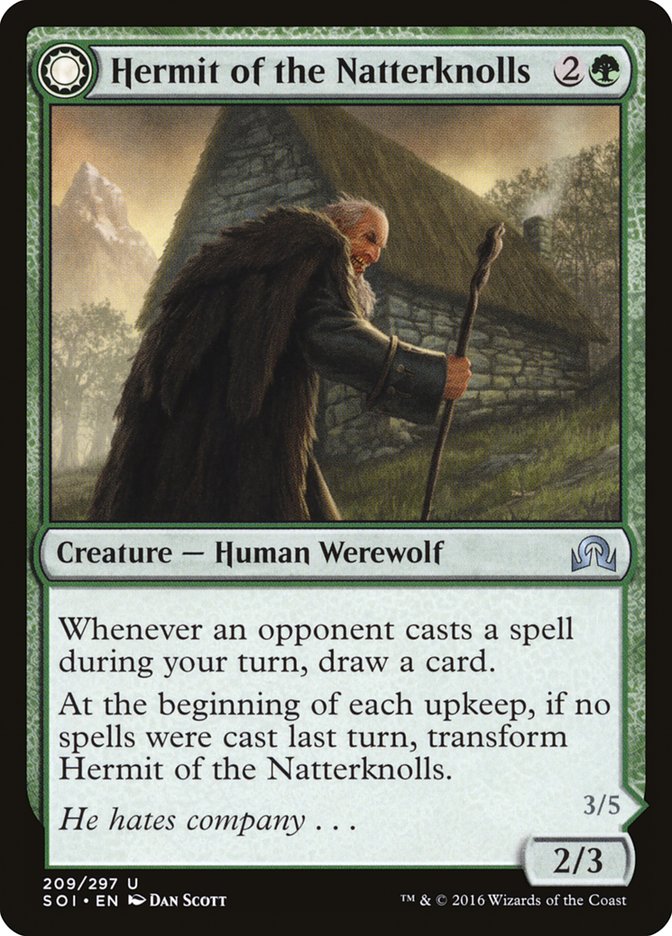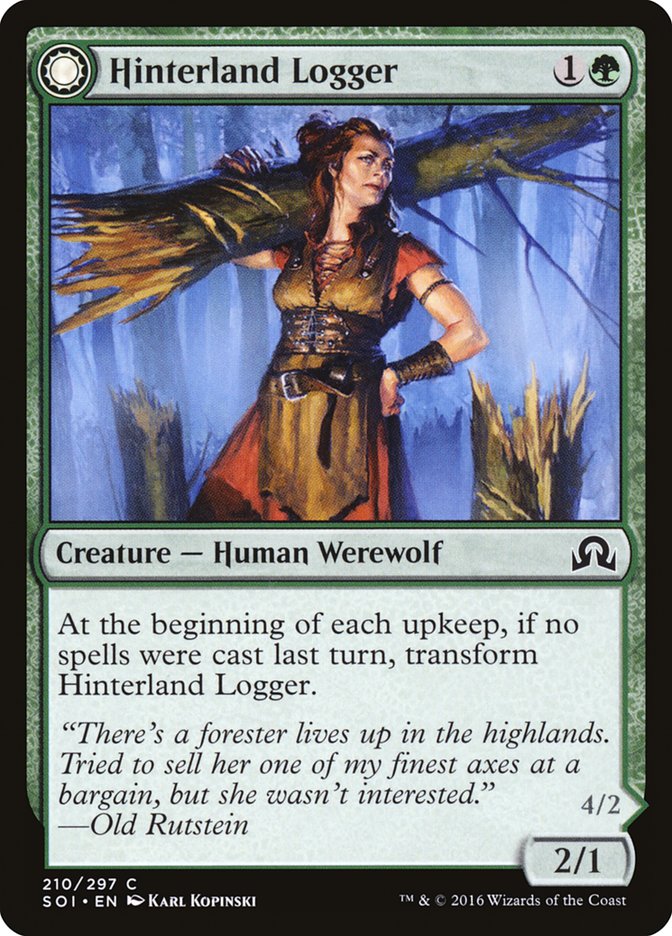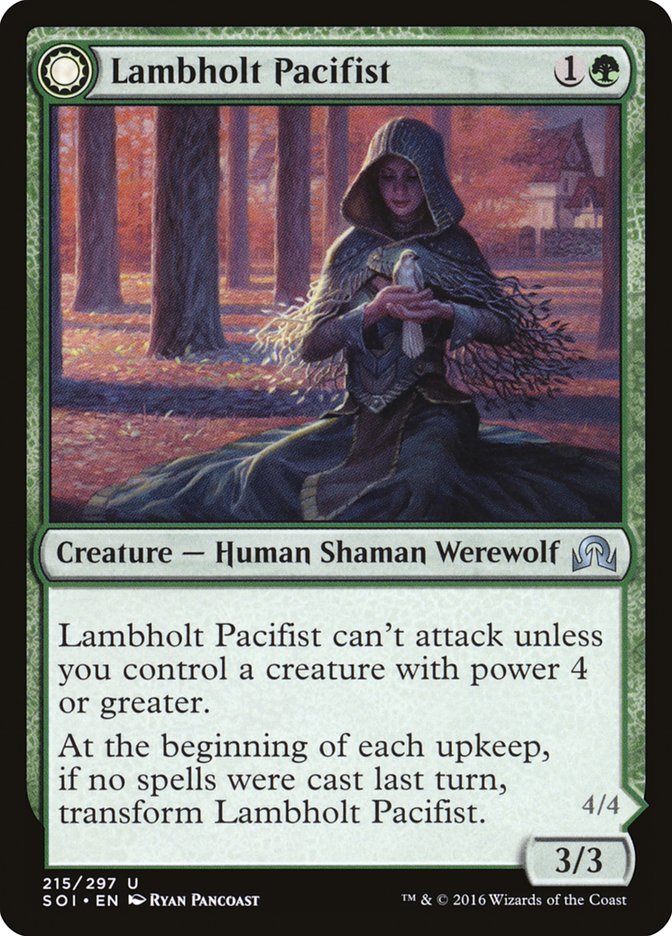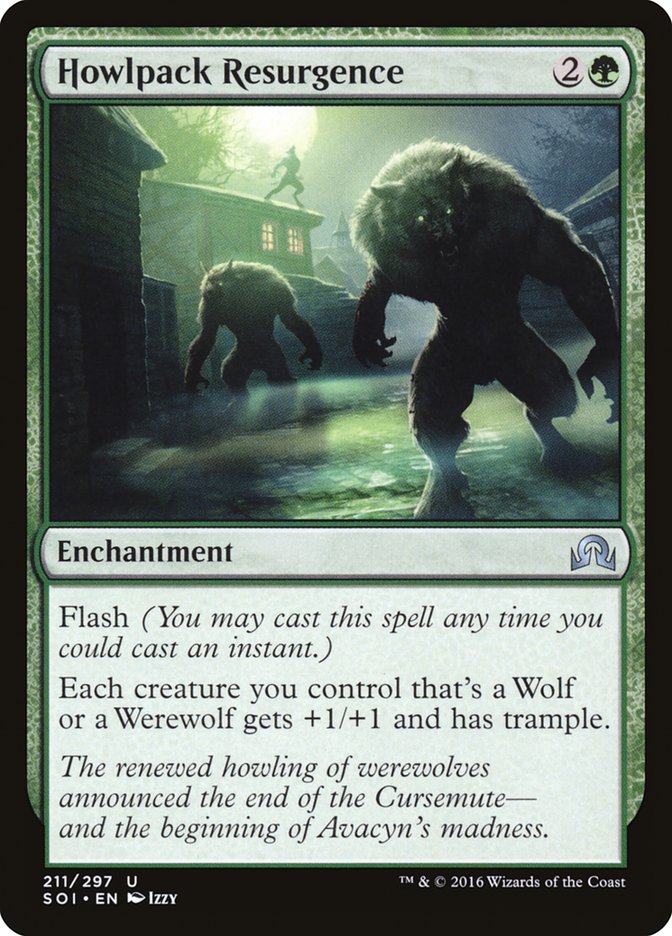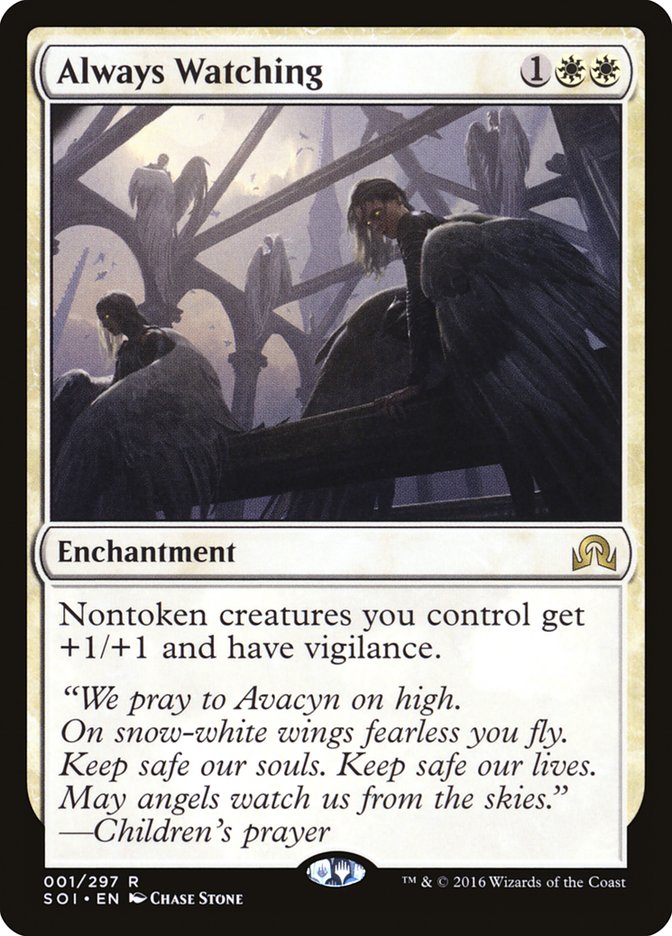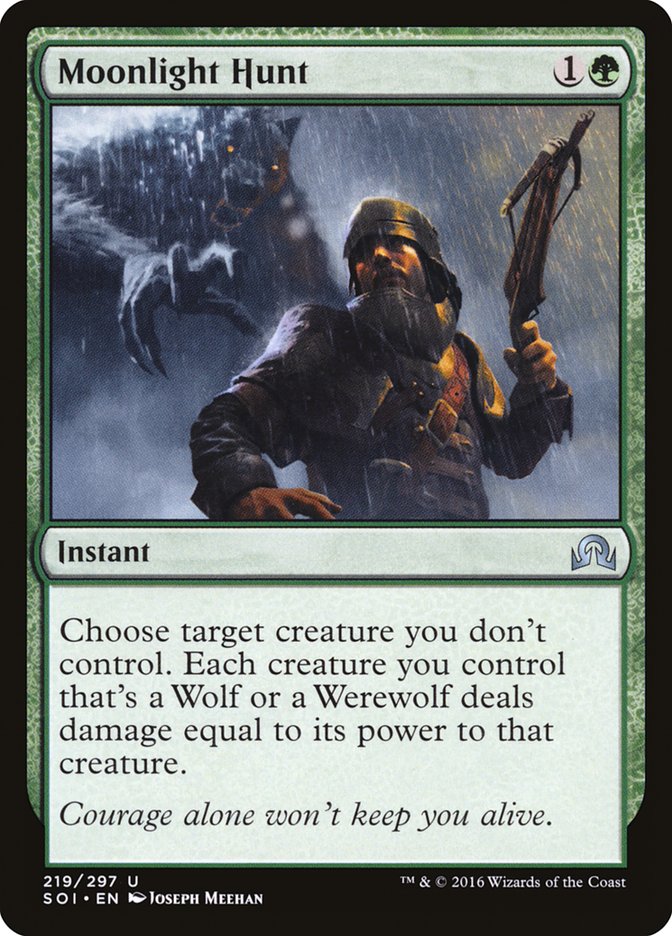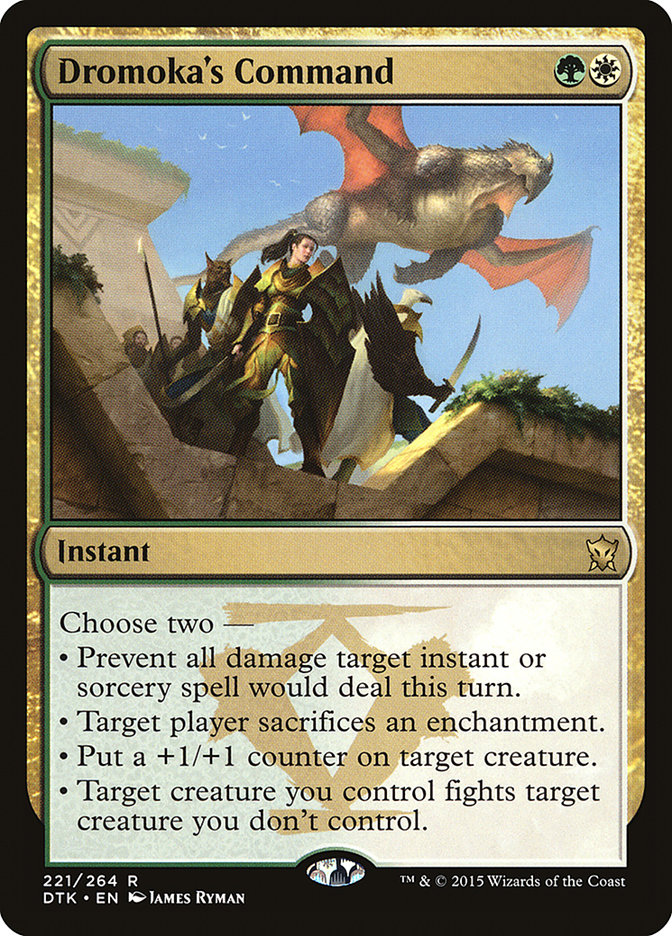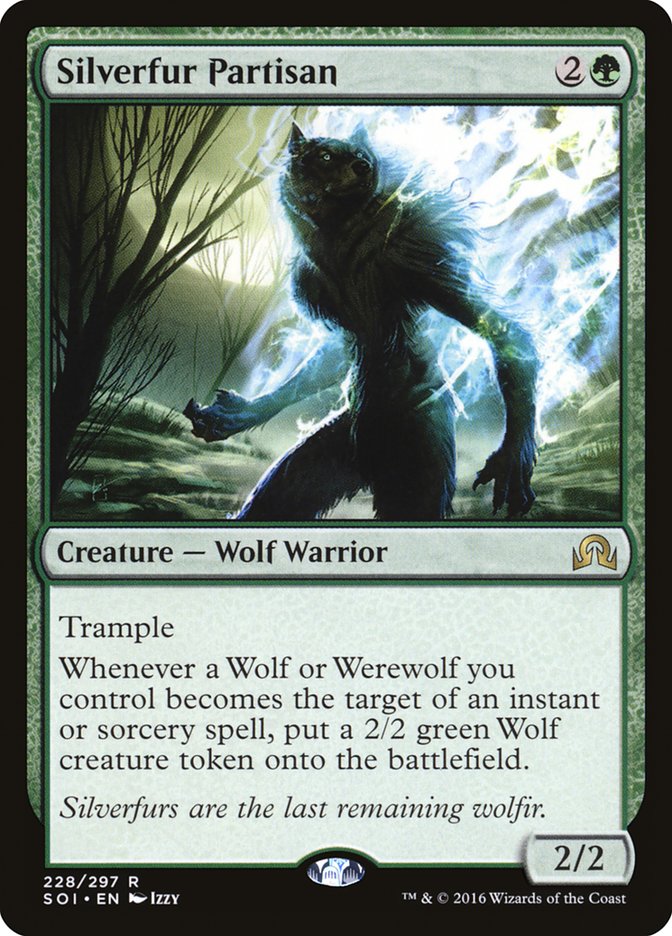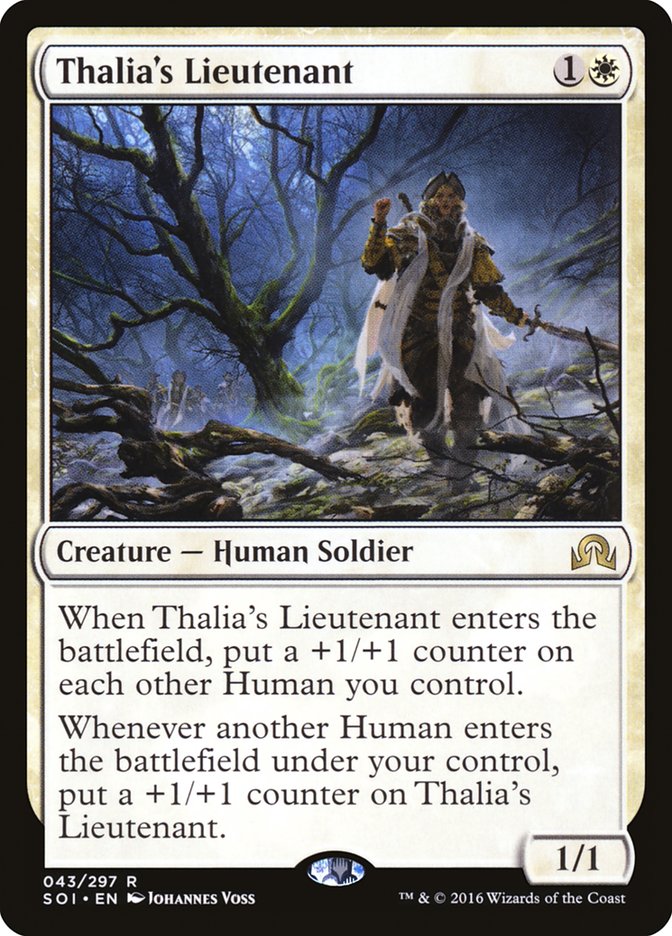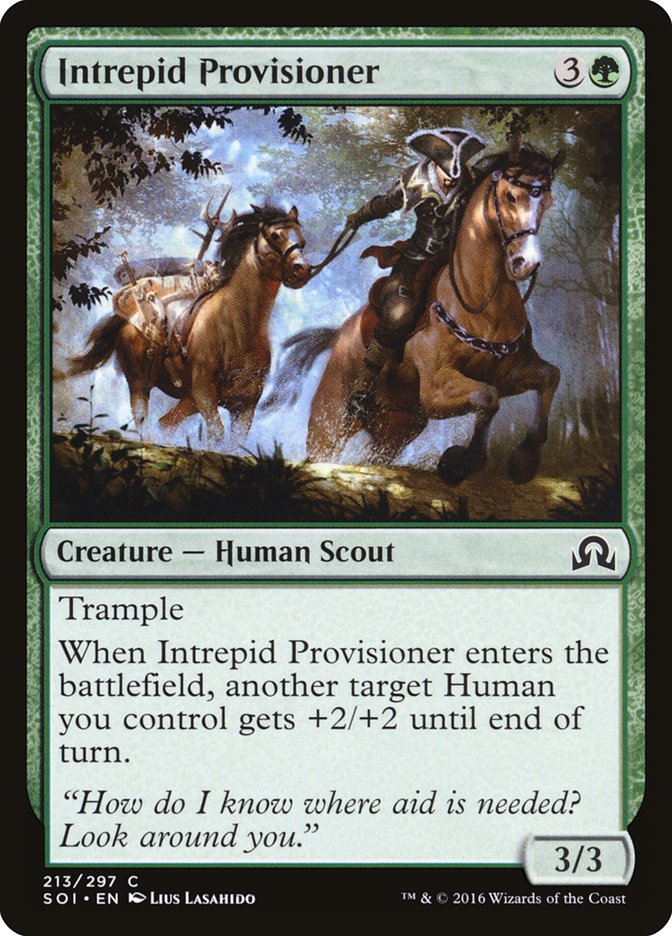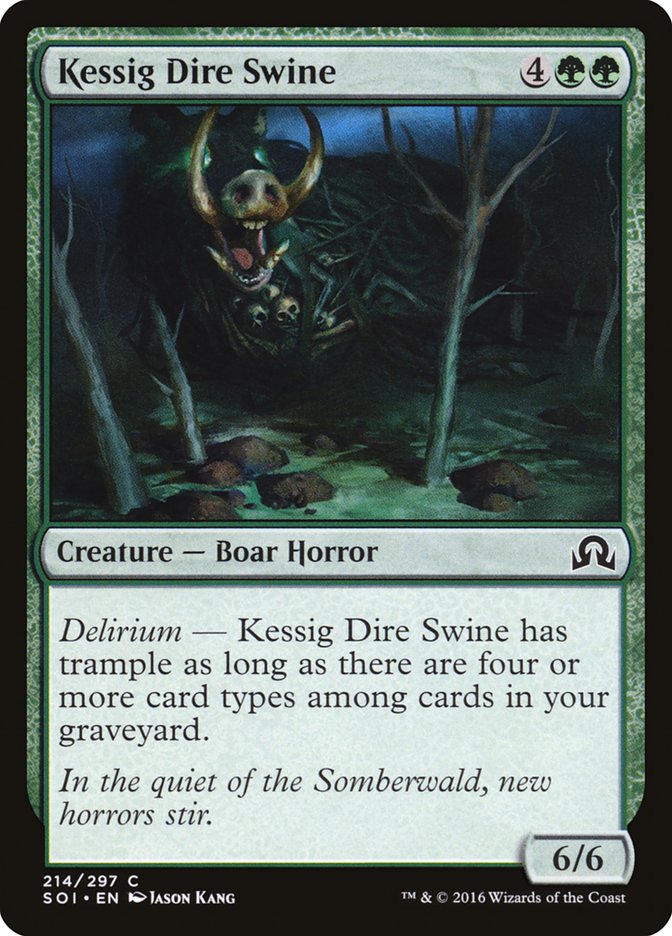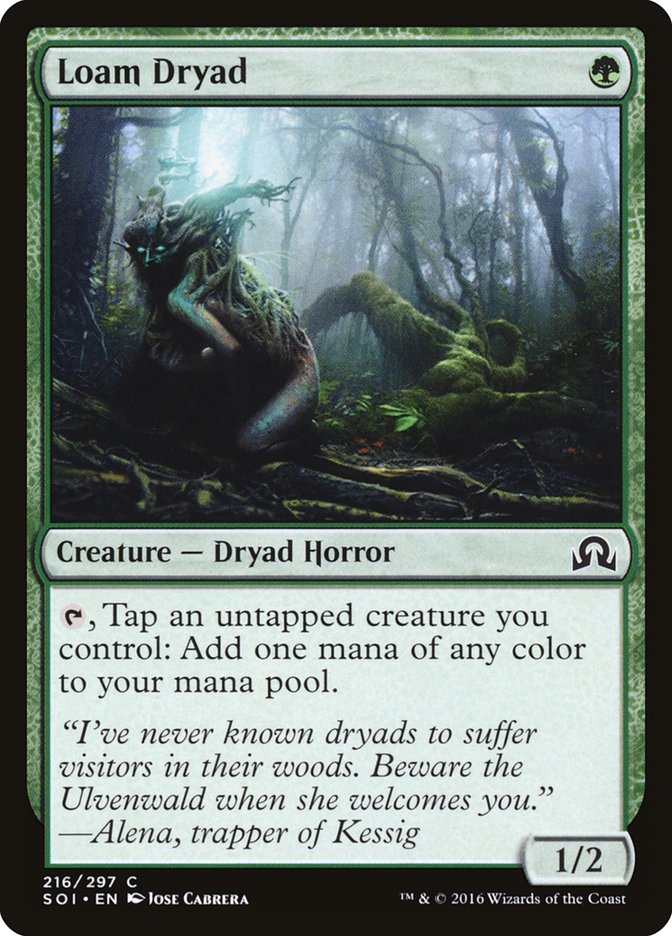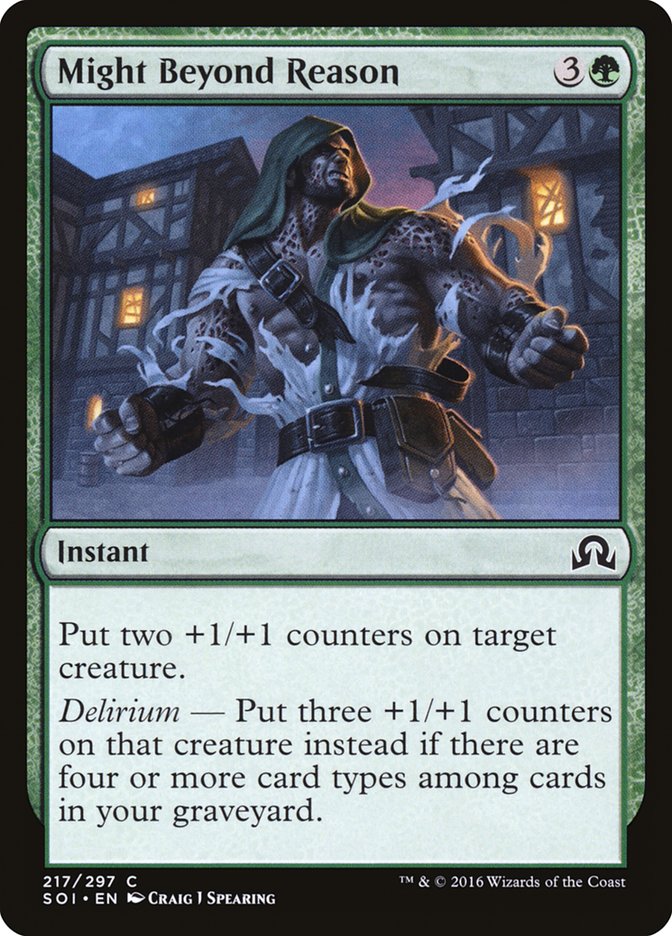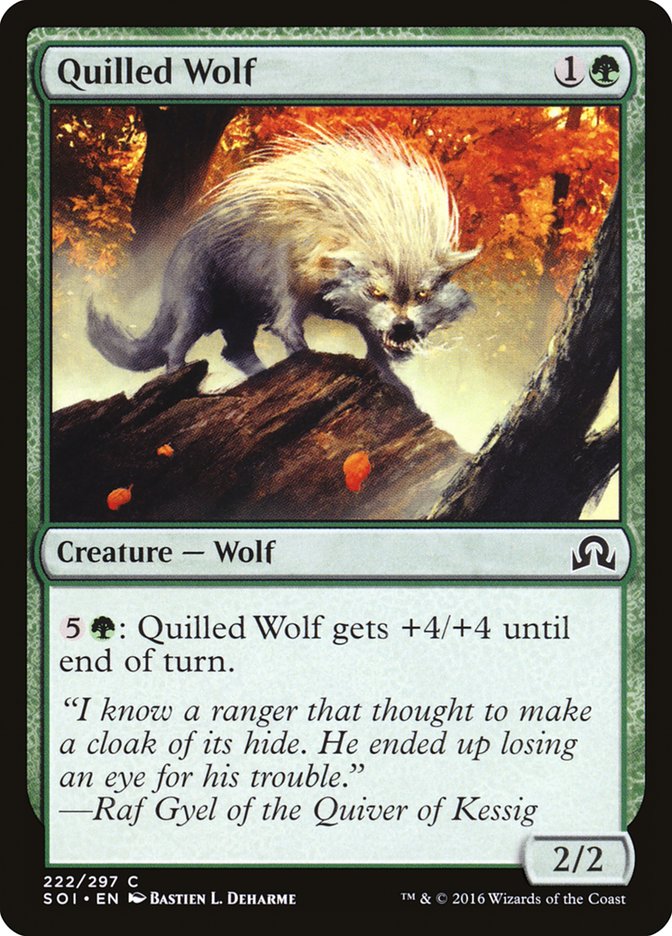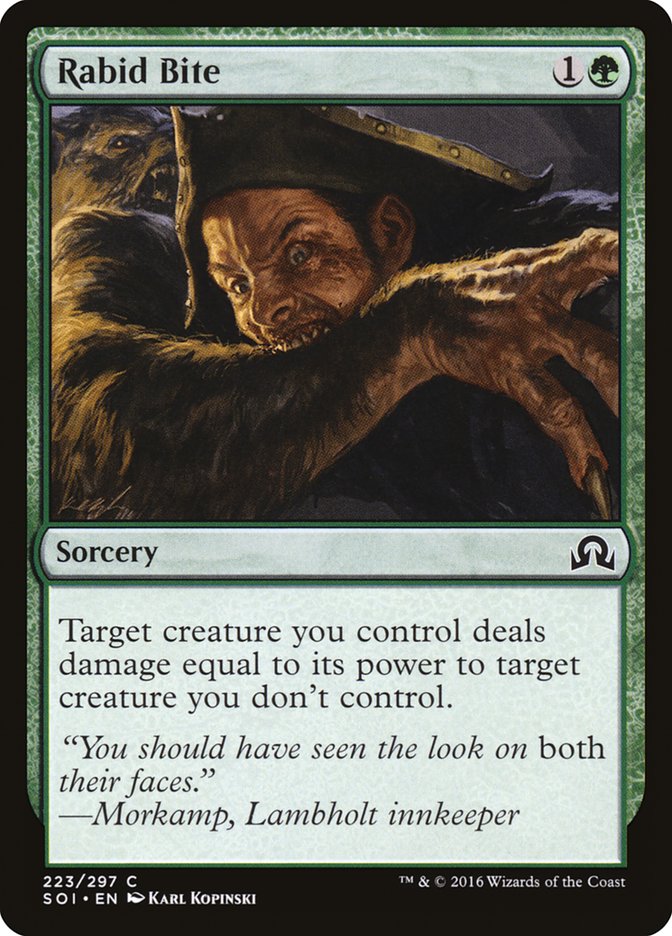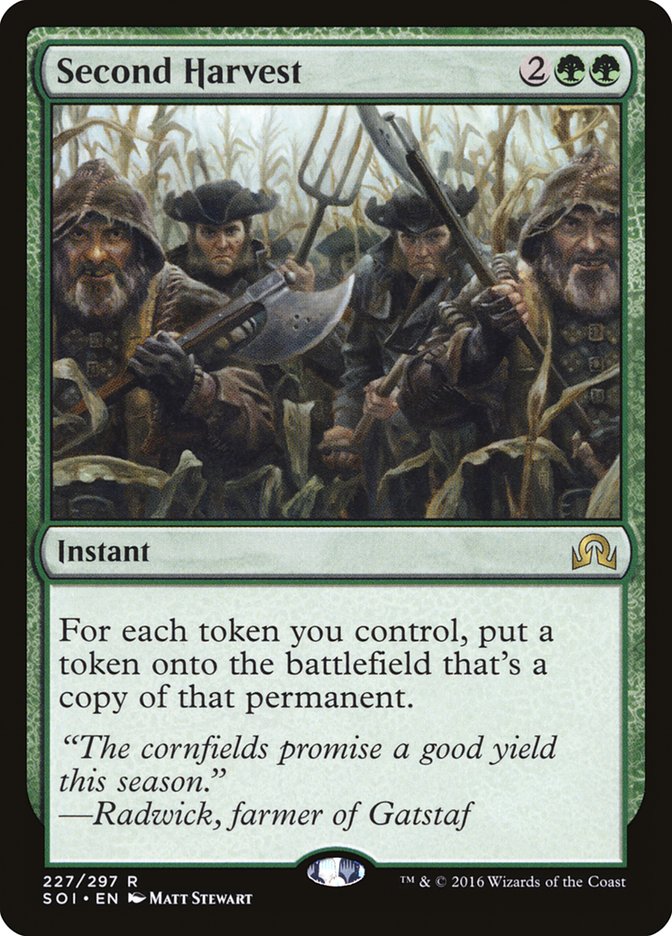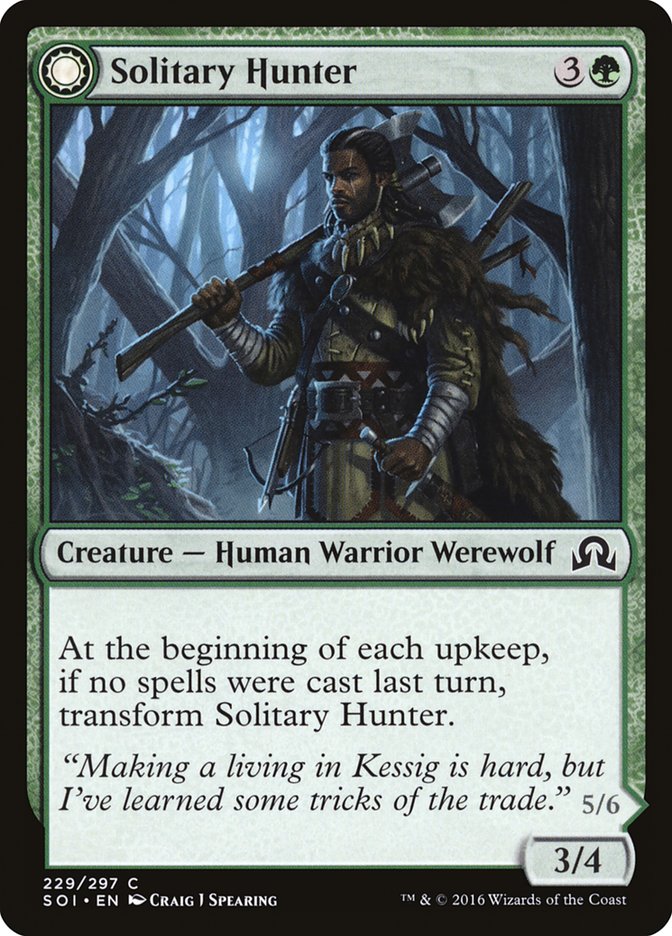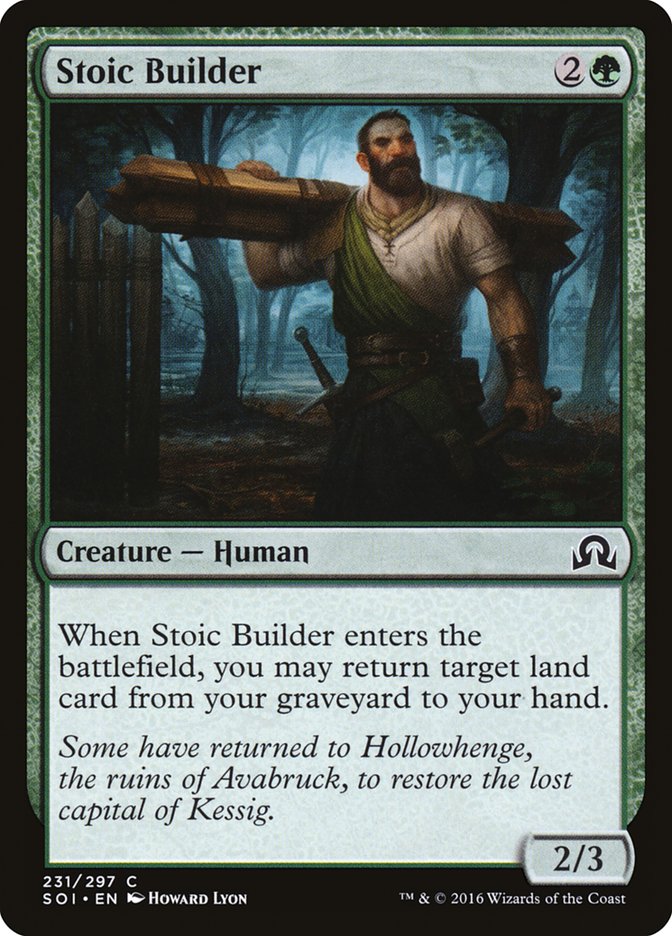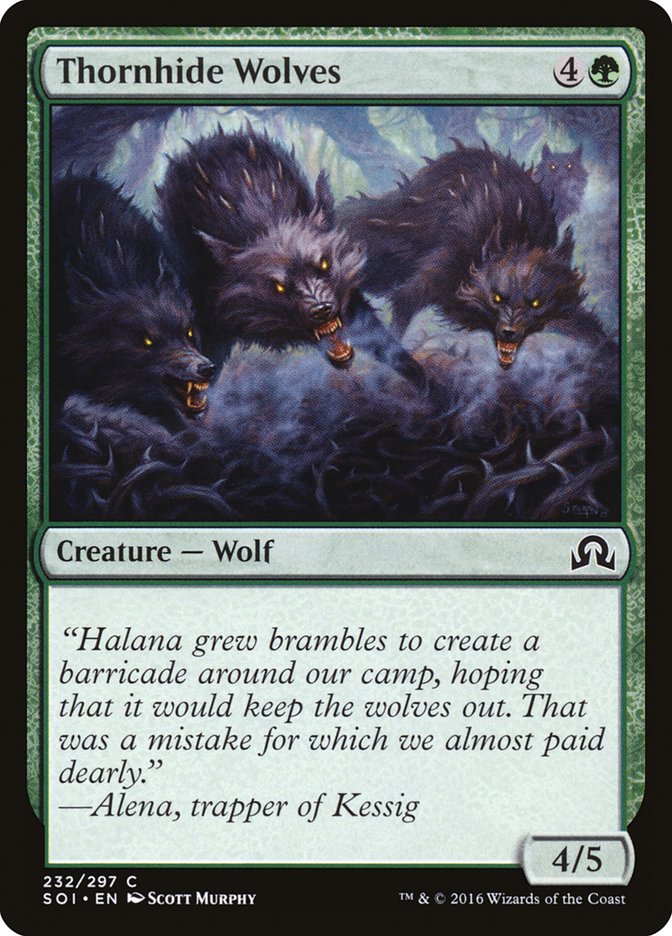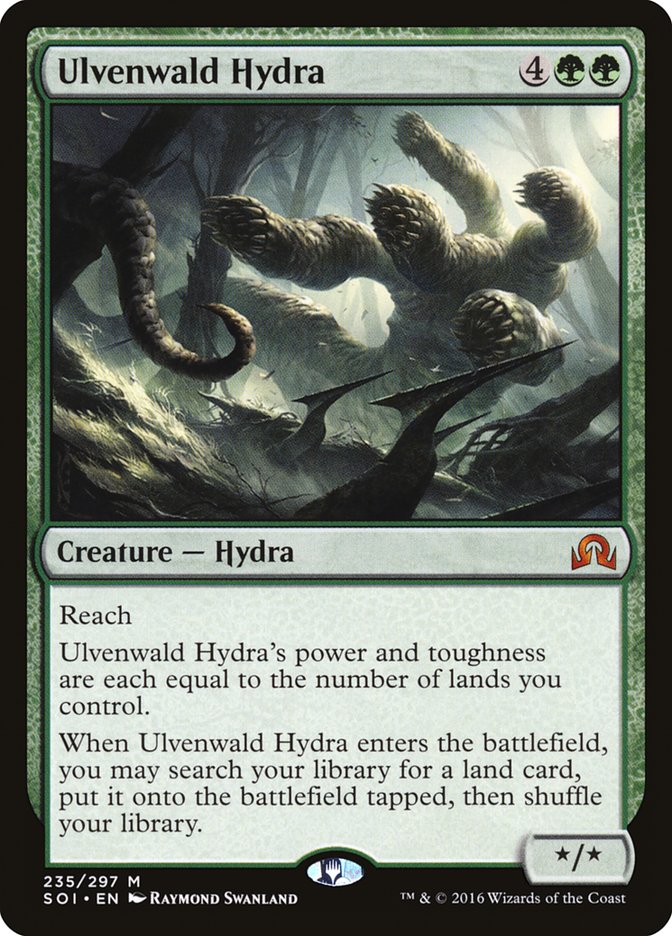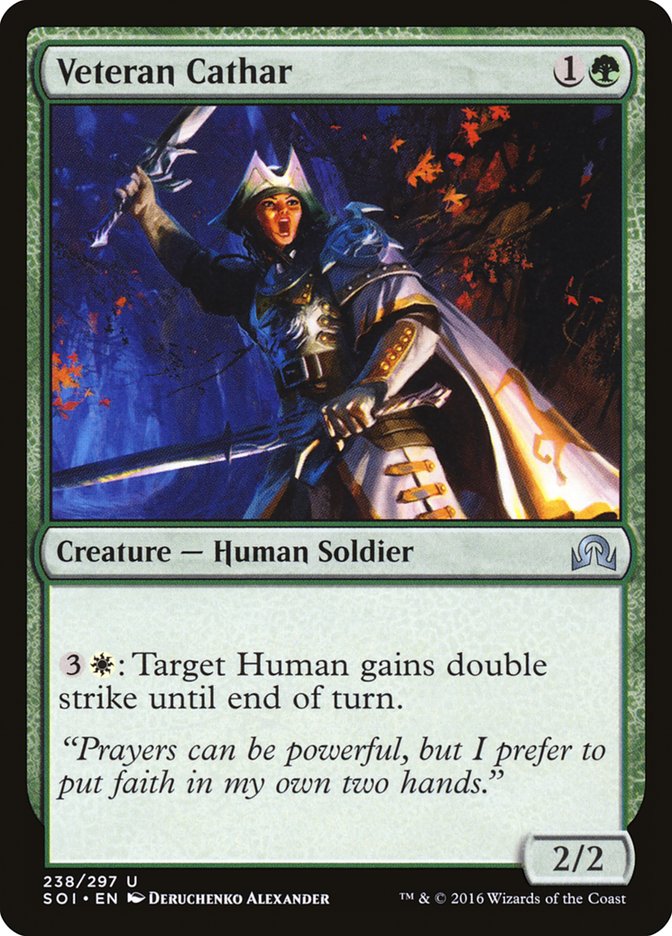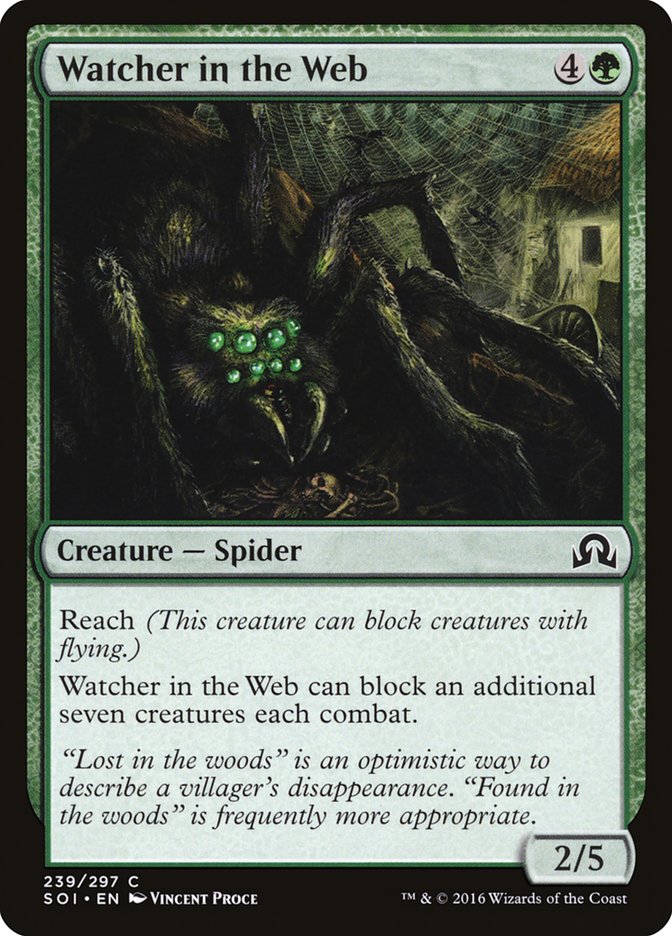Shadows over Innistrad has wasted no time making a huge impact on Standard. The new cards lend themselves to very different styles than we’re used to; and it’s quite clear that figuring out how best to utilize them is far from an easy task.
Last week, we covered Blue, Black, and Red. Today, I’d like to take a journey through the green cards of Shadows over Innistrad. This format is unlike anything we’ve seen lately, and I’ve got a feeling the decks people played this weekend will look quite a bit different from the decks people are playing next month, or even at #SCGINVI this weekend. But where to start?
While good advice, Aim High is not good for winning at Constructed Magic. It’s a Draft deck trick, and combat tricks need to be much stronger than average to make it in Constructed. Additionally, reach isn’t worth paying much for in Constructed, and a lot of what you’re paying for with Aim High is the reach.
Okay, now we’re talking about a Constructed card I can sink my teeth into. Autumnal Gloom is basically a 4/4 trample, hexproof creature for three, assuming you’ve got delirium. If you don’t, Autumnal Gloom gives you a pretty rapid way to get it, assuming you built your deck to achieve delirium.
Creatures (21)
- 1 Den Protector
- 4 Sylvan Advocate
- 4 Mindwrack Demon
- 4 Deathcap Cultivator
- 4 Obsessive Skinner
- 4 Inexorable Blob
Lands (22)
Spells (17)

This deck’s basic strategy is to use delirium to enable a bunch of under-costed, aggressive threats.
Obsessive Skinner may not look like much, but he’ll surprise you with just how much of an impact he has on the game (and how into skinning he is…). When you have delirium, the Skinner can come down as a 2/2 (or put the counter somewhere for virtual haste) and then grow to 3/3 on your opponent’s turn.
That’s already as much body as a Watchwolf, and it’s threatening to grant another counter every turn. A +1/+1 counter wherever you want is often quite a bit better than just +1/+1 worth of body, since it does things like make your Autumnal Gloom grow too big for Languish or make your Sylvan Advocate big enough to bust through theirs.
Obsessive Skinner’s upside is quite respectable, and the fail-state is still better than a 2/2 for two, since you can put the counter somewhere useful. Contrast this with Moldgraf Scavenger, for instance:
Moldgraf Scavenger has some appeal, as a 3/4 for two would be great. However, you’ve got to work to get it, and when you do, it’s not as big a battlefield presence as Scaleguard Sentinels. What’s worse, the fail-state is a 0/4, unlike the Sentinels, which at least had the decency to still hit for two. Moldgraf Scavenger isn’t terrible or anything; it’s just that you’d have to be really sure you’re getting the delirium active very early and very often.
I’m a bigger fan of Deathcap Cultivator, both here and in other decks looking for an accelerator. Making both colors is nice, particularly when ramping into Mindwrack Demon. Gaining deathtouch, though, lets us turn our mana creature into a legit game piece.
Traverse the Ulvenwald is one of the best cards in the set. Not only does it reliably and efficiently fix your mana, it turns into a near-Demonic Tutor with the only real cost being paid during deckbuilding. I cannot stress enough how vital it is to have a playset of these for deckbuilding purposes. They are going to show up in so many decks. Fortunately, they aren’t expensive (at least as of this writing).
So what you’re saying is “Buy Traverse while it’s still only five?”
Vessel of Nascency does a pretty good job of turning on delirium, but it is a bit slower than I’d like, at least for a deck with so many two-drops. I’d like it quite a bit better in a deck that went a little bigger, that took better advantage of the selection, and didn’t mind the tempo hit, maybe making up for it with sweepers or removal.
Soul Swallower may be on-theme, but it’s like an Inexorable Blob that costs more, hits slower, and puts all your eggs in one basket. Besides, I’m not really that into Inexorable Blob, anyway.
I’m really skeptical of Inexorable Blob. Maybe we just always have delirium, and we can just keep attacking, and we don’t get blown out by Draconic Roar and Fiery Impulse too much. However, I can’t help but feel like Tireless Tracker is enough stronger of a card that we should be using it instead.
Of course, I’m not sure we need to be so all-in on delirium. What if we just play a good old-fashioned Jund deck?
Creatures (20)
- 2 Dragonlord Atarka
- 1 Den Protector
- 1 Nissa, Vastwood Seer
- 4 Goblin Dark-Dwellers
- 4 Sylvan Advocate
- 1 Hedron Crawler
- 4 Mindwrack Demon
- 3 Tireless Tracker
Planeswalkers (2)
Lands (24)
Spells (14)

I would have said that Tireless Tracker is going to sneak up on people, but it has already enjoyed some success in its first days legal in the format, such as in Jim Davis’s #SCGBALT-winning Bant Company deck:
Creatures (27)
- 1 Hidden Dragonslayer
- 1 Den Protector
- 4 Jace, Vryn's Prodigy
- 1 Nissa, Vastwood Seer
- 4 Bounding Krasis
- 4 Reflector Mage
- 4 Sylvan Advocate
- 2 Archangel Avacyn
- 2 Tireless Tracker
- 4 Duskwatch Recruiter
Lands (25)
Spells (8)

The thing about investigating every time you play a land is that you are going to hit a lot more land drops. That means a lot of extra cards, all while your Tracker keeps growing.
While the Tracker is potentially easy to kill when you first play it, you can often play it as a virtual four-drop and ensure you get some value out of it. Just cast it before you’ve played your land for the turn, and at least you get a Clue out of the deal when they kill it. If your land was Evolving Wilds, all the better.
If we’re gonna make a 3/3 for four with no defensive ability and no enters-the-battlefield ability work, we’re gonna need a pretty big payoff. Of course, Briarbridge Patrol does promise a massive mana cheat if we have some convenient way to both trigger it and make sure we’ve got a huge creature in our hand.
Tamiyo’s Journal is a funny sort of “Clue” enabler, not only giving us a Clue a turn but letting us cash in an Ancestral Recall’s worth of Clues for a Demonic Tutor. That might not seem like that crazy good of a deal or anything, but remember, that’s also six mana we don’t have to spend cracking the clues. A zero-mana Demonic Tutor is a lot better than three unopened Clues in most situations, particularly if we build our deck to ensure that activating Tamiyo’s Journal is usually game over.
If we have already amassed three clues and have a Briarbridge Patrol on the battlefield, we can play the Journal and then immediately sacrifice the clues to search our deck for Ulamog, the Ceaseless Hunger or Kozilek, The Great Distortion. Alternatively, if we’ve got either Eldrazi in our hand, we can sacrifice the Clues to find the Patrol and cheat the Eldrazi directly onto the battlefield. The Patrol’s ability actually works the turn you cast it, so you can really surprise someone with it.
Creatures (13)
- 1 Den Protector
- 4 Jace, Vryn's Prodigy
- 1 Disciple of the Ring
- 1 Ulamog, the Ceaseless Hunger
- 1 Kozilek, the Great Distortion
- 1 Briarbridge Patrol
- 4 Tireless Tracker
Lands (24)
Spells (23)

This one’s going to take a few reads to decipher, isn’t it?
Yeah, but how do you think your opponent’s going to feel? This list is horribly untuned, and so radical of a departure from conventional decks that it will need some work, but it does some powerful things. For instance, if you can make two Clues a turn, you can actually use Tamiyo’s Journal every turn (since it gives you a Clue, too). If you just find Part the Waterveil every turn for a couple turns, you can get a pretty big advantage.
This list isn’t that great at keeping three a turn coming, so we’ve only got two Part the Waterveils, but it’s possible we’re supposed to embrace cards like Erdwal Illuminator and Ongoing Investigation to try to maximize our chances of “going off.”
Weirding Wood actually does a surprising amount of work in this deck. For starters, it is mana acceleration on par with Nissa’s Pilgrimage, though it fixes your colors and nets a mana the turn you cast it if the land you are targeting is untapped.
While Nissa’s Pilgrimage does put a second (sometimes even a third) land into your hand, Weirding Wood cantrips more easily than most Clues. It’s often easy to just play it on turn 4 and then tap the land you enchant to crack the Clue.
In addition to the clue synergies, the acceleration, and card advantage (and it really is a two-for-one), Weirding Wood is also a surprising combo piece when played on a Lumbering Falls and combined with Disciple of the Ring. Once your Lumbering Falls is a creature, you can tap it for two and then use one mana and exile a sorcery or instant from your graveyard to untap it. Repeat as many times as your graveyard can take and cast Ulamog or Kozilek or Part the Waterveil or whatever.
This card is great! Whether used as a bullet, as part of a tutor package, or just for value in a midrange deck that wants a big card drawer, Seasons Past is a surprisingly powerful card-draw spell that is going to completely take over a lot of games. Expensive multi-Regrowths aren’t usually dominating tournament play, but they’ve never made one this strong before, so we’ll see.
Too modest of a rate to get excited about, too unreliable of a Clue enabler to go to the trouble.
A quality sideboard answer to Dragonlord Ojutai and Ormendahl, Profane Prince.
You gotta try pretty hard to justify Confront the Unknown in Constructed, but if we’re going to do this, let’s do this:
Creatures (25)
- 4 Knight of the White Orchid
- 4 Bygone Bishop
- 1 Archangel Avacyn
- 4 Thraben Inspector
- 4 Tireless Tracker
- 4 Duskwatch Recruiter
- 4 Graf Mole
Lands (23)
Spells (12)

As you can imagine, this list is probably just better off without Confront the Unknown, maybe going a little closer to a more traditional Company deck. Nevertheless, the Clue synergies are actually quite decent.
Spending two mana to draw a card from your Clue is fine, but it’s nothing to write home about. However, getting an extra three life to boot? Now we might be onto something. Besides, it’s not like a 2/4 for three is such a bad deal in the first place.
While not explicitly “on-theme,” Duskwatch Recruiter is just a powerful card, and besides, it does have a few synergies with what we’re doing. It can help find our “combo” pieces, and if we’re spending a lot of mana drawing cards, it’s nice to save some mana when playing them (thanks to Duskwatch Recruiter’s flipped side).
Ulvenwald Mysteries can be part of a dedicated Clue plan, giving us a free 1/1 token for every Clue cracked, in addition to providing us with a plethora of Clues over time (since many of our creatures are going to give us Clues unless they die, and if they die, then the Ulvenwald Mysteries will give us Clues as to what happened).
Ulvenwald Mysteries can also just be used as a defense measure against removal, particularly out of the sideboard. For instance:
Creatures (30)
- 4 Knight of the White Orchid
- 4 Dragon Hunter
- 3 Kytheon, Hero of Akros
- 3 Archangel of Tithes
- 4 Consul's Lieutenant
- 4 Thraben Inspector
- 4 Thalia's Lieutenant
- 4 Tireless Tracker
Lands (22)
Spells (8)

Why don’t you put Ulvenwald Mysteries in that Erdwal Illuminator/Ongoing Investigation deck you were describing above?
The one I alluded to, but didn’t actually list above? Fine. Here:
Creatures (23)
Lands (26)
Spells (12)

Mysteriously, I sense this is not the only three-cost green enchantment that makes 1/1 tokens when the condition is met in this set…
Crawling Sensation is another delirium enabler (thanks to the self-mill ability) and a payoff for your other delirium enablers (giving you random 1/1s here and there). It’s a little slow but produces a decent advantage when it gets going.
Creatures (18)
- 1 Groundskeeper
- 1 Den Protector
- 1 Greenwarden of Murasa
- 4 Mindwrack Demon
- 4 Deathcap Cultivator
- 4 Tireless Tracker
- 3 The Gitrog Monster
Lands (23)
Spells (19)

This list has a lot of similarities to the delirium deck above but aspires to go a bit bigger, playing a The Gitrog Monster strategy.
The Gitrog Monster can be a bit unwieldy at times, but it is a 6/6 for five that gives you selection (turning a land each turn into an extra card), not to mention drawing you an extra card off each Evolving Wilds, as well as each self-mill that hits a land. Obviously, this is perfect for a Crawling Sensation deck!
Sacrificing Drownyard Temple is particularly nice, since you can just get it back every turn. Even if you don’t draw one, you’re usually going to be able to find one from the self-mill. Similarly, Groundskeeper can let us get back basics we’ve sacrificed or milled:
Groundskeeper is a little fragile, but it’s a great way to put your extra mana to use in the mid-game, as well as ensuring you keep hitting your land drops. I just wish we could find a way to get it alongside Jace, Vryn’s Prodigy for even more mondo-combo action…
Creatures (18)
- 2 Groundskeeper
- 1 Den Protector
- 4 Jace, Vryn's Prodigy
- 1 Greenwarden of Murasa
- 4 Mindwrack Demon
- 3 Tireless Tracker
- 3 The Gitrog Monster
Planeswalkers (2)
Lands (25)
Spells (15)

Jace, Vryn’s Prodigy and Kiora, Master of the Depths give us even more ways to take advantage of Crawling Sensation. If we wanted to go even harder, I could even imagine us playing Deathmist Raptors and more Den Protectors so as to get even more profit from the self-mill. My concern, however, is making sure we keep enough interaction, enough removal to not get run over when someone Reflector Mages our Mindwrack Demon.
Fork in the Road is a possible consideration, triggering all of our Crawling Sensation / The Gitrog Monster stuff, but the rate is pretty bad. Even when we’re getting a bonus 1/1 or card, we’re only barely paying for the premium we spent compared to better options. Sometimes, we won’t even get a bonus at all!
Sometimes?
Cryptolith Rite does a close-enough Earthcraft impression that it actually seems decent. It has two major limitations compared to Earthcraft (a card so busted, by the way, it’s banned in Legacy). First, Earthcraft didn’t care if the creature had summoning sickness, unlike Rite. Second, Earthcraft’s ability to untap lands could be particularly abused with lands that produce more than one mana (usually thanks to Fertile Ground or Wild Growth).
You can still abuse the massive mana production, but it’s gotta be a bit more of a one-to-one ratio between creatures and mana. I would imagine some kind of sick Secure the Wastes into really big Secure the Wastes deck might be the place to start. Alternatively, you could use Cryptolith Rite to make your Eldrazi Scions power out big Eldrazi twice as quickly.
What happened to one creature, one mana?
It’s Earthcraft! It was meant to be broken.
A cool quest, but at five mana upfront, there’s little chance this is a big enough payoff to go to the trouble.
Auras aren’t naturally well-suited to Constructed, so it takes a particularly strong one to catch our interest. This is not a particularly strong one.
I enjoy when these Spiders are Constructed-playable. This is not the one, however.
Those were the days…
We discussed Werewolf decks a fair bit Friday, which can be found here. While there’s some cool things going on, I’m not sure a dedicated Werewolf strategy has enough raw power yet. Hermit of Natterknolls is fine, I guess, but in Constructed, we’re going to get the 2/3 for three a lot of the time. When it turns into a 3/5 with upside, that will be the spot where our opponent decides to Reflector Mage it or Ruinous Path it, or whatever. That said, let’s see if we can’t approach Werewolves from a new angle, just below.
Without even a cool ability like Hermit of the Natterknolls, Hinterland Logger is really all in on being a two-cost Werewolf. It is cute that she gets up to four power, which is enough to get Lambholt Pacifist’s rear in gear.
Lambholt Pacifist was born in the wrong era. Just a set ago, it would have had no shortage of 4/4s for three (or less) to help motivate it. Instead, we’ve got pretty slim pickings in that area, at least at the moment.
Pitiless Horde is basically the only option for a three-drop actually big enough that’s worth playing. Such a deck could potentially also use Mindwrack Demon, but I’d be more excited about Surrak, the Hunt Caller. Lambholt Pacifist and Surrak are perfect for each other.
Of course, we don’t actually have to rely on others if we get our Pacifist up to four power itself. For instance:
If we go dedicated Wolves/Werewolves, we can use Howlpack Resurgence as a reliable way to get the Pacifist into the red zone. If we dip into white, we can actually pick up a pretty big boost in terms of Pacifist enablers.
Now we’re talking! With eight Anthems to play on three, we’re going to be able to consistently negate the Pacifist’s drawback entirely.
Creatures (23)
- 4 Hinterland Logger
- 3 Silverfur Partisan
- 4 Lambholt Pacifist
- 4 Pack Guardian
- 4 Duskwatch Recruiter
- 4 Hermit of the Natterknolls
Lands (24)
Spells (13)

Flash creatures (and enchantments) work great with Werewolves, letting us take a turn off while still being able to make our plays. Pack Guardian is already potentially six power at instant speed, but Howlpack Resurgence is effectively a double pump, since both the Guardian and its buddy are Wolves. Just remember that the token doesn’t get the bonus from Always Watching!
Even when we don’t make a token, though, Pack Guardian is a great way to play around sweepers, and it’s even got enough power to persuade the Pacifist to get in there.
I worry that we’re a little too light on creatures, but assuming we’ve got enough, Moonlight Hunt is cheap and an instant. It’s concerning just how reliant we are on having a creature to be able to get opposing creatures off the table; however, I wanted to try at least one, because it might be just what we’re looking for.
If they print a couple of sick one-drop green Wolves in the next set? It’s a whole new ballgame…
Dromoka’s Command is yet another way to enable the Pacifist, usually giving it a +1/+1 counter while fighting an opposing Jace to death. For extra fun, Dromoka’s Command your Siverfur Partisan and get a bonus Wolf!
Silverfur Partisan is a curious tribal lord. On the surface, it would appear to be mostly about making it a little more punishing for opponents to use removal on your Wolves. However, the ability actually works regardless of who targets the Wolf, so if we wanted to, we could actually abuse it by targeting it over and over. For instance:
Creatures (16)
Planeswalkers (4)
Lands (20)
Spells (20)

Zada, Hedron Grinder decks have always suffered from “What do you do if you don’t draw Zada?” However, now we have both Zada and Silverfur Partisan to take advantage of the Expedites and Slip Through Spaces, not to mention Traverse the Ulvenwald to find either one. See, even though Silverfur Partisan looks like a tribal lord, you can play it as your only Wolf if you are just going to keep targeting it. Every Expedite, every Slip Through Space, every pump spell, that’s another Wolf.
Switching back to G/W, we can also get away from the Wolf theme, instead building around Humans. After all, as good as Howlpack Resurgence is, this card’s even better (and the Human tribe is way bigger and better):
Alongside Always Watching, Thalia’s Lieutenant has catapulted Human-based aggro strategies into an early defining influence on the metagame. Of course, folks like Lamboldt Pacifist and Duskwatch Recruiter are just good, honest Humans, which entitles them to their fair share of Thalia’s counters.
Creatures (29)
- 2 Surrak, the Hunt Caller
- 4 Dragon Hunter
- 2 Kytheon, Hero of Akros
- 1 Archangel Avacyn
- 4 Thraben Inspector
- 4 Thalia's Lieutenant
- 4 Tireless Tracker
- 4 Lambholt Pacifist
- 4 Duskwatch Recruiter
Lands (23)
Spells (8)

Tireless Tracker is another way to surprise your opponent with a creature big enough to wake up the Pacifist. It doesn’t work on turn 3, of course, but it does work after that. This means we might play a different two-drop on turn 3, then the Pacifist and a one-drop on turn 3 sometimes. I’m just glad Tireless Tracker is a Human!
There really are a lot of good humans to choose from right now. Even Surrak, the Hunt Caller is a human!
I love cards like this but will love them even more when one is good enough for Constructed. The play pattern is good, and there is a surprising amount of room for tactics. Maybe if it was like 1GG for a legendary 3/3 with trample that gives something +3/+3 and trample until end of turn when it enters the battlefield?
For Draft only, unless you are bored and want to hog the attention of the coverage people trying to figuring out what the hell you’re doing when you go ham on your opponents. Alternatively, you could just be a glutton for punishment.
Loam Dryad might not look like much, but like Springleaf Drum, it just needs the right context. There’s a real shortage of cheap acceleration these days, and if you can make it work, Loam Dryad is better than it looks. The key is that the creature you tap can be summoning sick, so if you are going to play two creatures in the same turn, it’s like the Loam Dryad’s tap ability is “free” (assuming you weren’t going to block).
Loam Dryad also provides five-color fixing, which, combined with Evolving Wilds and/or Traverse the Ulvenwald, might lead to some interesting splashes.
A Limited trick that’s too expensive for Constructed.
Maybe a mono-green Wolf deck could be desperate enough for a two-drop to want Quilled Wolf, but that’s about the only shot this card has in this format.
It is kind of interesting that you get to target your creature (for the purpose of Silverfur Partisan?), but this is just so much harder to use than something like Dromoka’s Command, for instance. It’s not just the sorcery vs. instant thing, though that is a big deal. It’s also that the versatility of Dromoka’s Command ensures we can more often put it to use in some fashion, even if having a creature damage another creature isn’t good in a given battlefield position.
We’re not exactly lining up to play Naturalize, and an extra mana to investigate is kind of a modest rate for Constructed.
While Sage of Ancient Lore is a stronger card than Maro, times have changed. It’s hard to get into a five-drop like this when Archangel Avacyn, The Gitrog Monster, and Dragonlord Ojutai are all legal.
While the most obvious use of Second Harvest is to copy creature tokens for double the beatdown, the more exciting use is to copy all of your Clues, which do, in fact, count as tokens. The even more exciting use is to copy all of your Flameshadow Conjuring tokens, including the copy of Possessed Skaab…
A 5/6 for four would not be particularly impressive, and Solitary Hunter is going to be a 3/4 a lot.
It’s a bit of a slim chance, but that Stoic Builder can actually get back nonbasic lands (unlike Groundskeeper) means it’s actually got a shot. Cartographer was playable, way back in the day, and Stoic Builder is even bigger! Of course, creatures are better nowadays and Wasteland is less legal, but we might be able to find a use for this creature somewhere. I don’t see the spot yet, but I’ll be keeping an eye for when and where it might be worthwhile over Den Protector (which has a monstrously better rate and is more versatile).
Thornhide Wolves, on the other hand, does not have a shot. It doesn’t do anything novel and has a bad rate by Constructed standards.
I’m curious about this new fixed Primeval Titan. Finding Mirrorpool or Mortuary Mire leads to some interesting recursive options. Finding Sanctum of Ugin or Shrine of the Forsaken Gods can help fuel an Eldrazi Ramp deck. Finding Westvale Abbey or a creature-land might just be awesome. Whatever we find, Ulvenwald Hydra usually starts out as a 7/7 and can grow much, much larger. Even if they kill it, we’re typically up a spell-like effect from the nonbasic we found.
PSA: Ulvenwald Hydra has reach, not trample! This is important to remember on both sides!
Double strike can be abused, and green is a color that typically appreciates it more than red (and doesn’t get it without white or red involved). Veteran Cathar is a Human, which is a great tribe. The problem, though, is that so expensive an activation cost is risky in Constructed. If someone responds with a removal spell, you are down a lot of mana.
If this thing could block like ninety-two more creatures, than we might be talking. As printed, however, it doesn’t have a leg to stand on. Don’t get caught using it in Standard…


